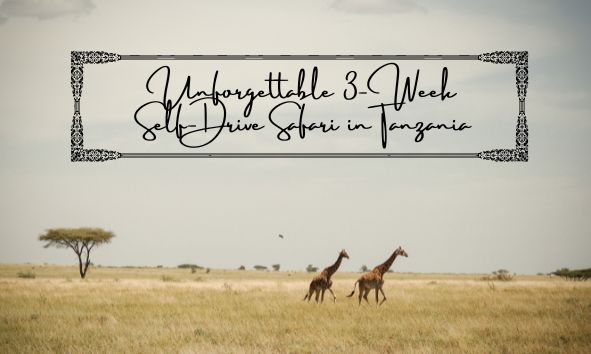
Unforgettable 3-Week Self-Drive Safari in Tanzania: Your Ultimate Adventure
“Pole Pole, Hakuna Matata”
Endless (dirt) roads, rolling plains, the great “rift”, scattered Masaai villages, and some of the richest biodiversity in the world: Welcome to Tanzania! And it will leave you speechless. In my opinion, Tanzania is a country best explored at your own pace and as such perfect for a road trip. If you are planning an unforgettable self drive safari to Tanzania, this travel guide has you covered. Although incredibly rewarding, it may not be the right thing for everyone, and surely requires plenty of pre-planning to get the most our of your trip. Below you will find important information, insider tips & tricks to ensure you have an amazing trip.
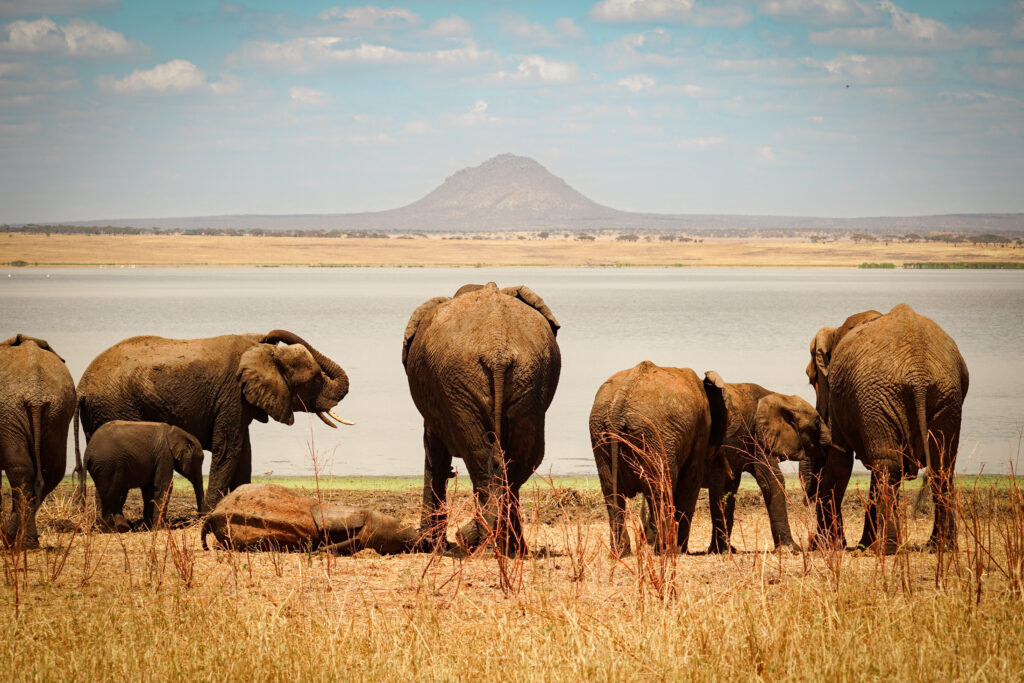
Some Basics: Tanzania Travel Guide
What is Tanzania famous for?
Tanzania is a country of superlatives: it has an astounding amount of biodiversity, and is home to the tallest peak in Africa – Mount Kilimanjaro and the largest intact caldera in the world – the Ngorongoro Crater. You will find pristine, laid-back beaches in Zanzibar. And for safari lovers: it’s one of the world’s prime destinations to see the Big 5 with twenty-two national parks!
Is Tanzania good for Honeymoon?
Having spent my Honeymoon there: Absolutely yes! Whether action, romance, or relaxation: the different activities will make your honeymoon memorable for a lifetime. Some popular travel itineraries include a hike up to Mount Kilimanjaro, a Safari, and finally relaxation and beach time on the island of Zanzibar.
What types of activities can you do in Tanzania?
Safari – Self-drive safari, game drive, walking safari
Doubtlessly, one of the prime activities in Tanzania is to go on a Safari. Regardless of whether you prefer the flexibility and freedom of a self-drive safari in Tanzania, a guided safari tour in a shared 4×4 vehicle, or a walking safari, Tanzania offers the perfect safari experience for everyone.
The famous Wildebeest Migration: Depending on the season, you can witness over 1,5 million wildebeest migrating between Kenya and Tanzania in the eternal circle of life. Regardless of whether you choose to experience the calving season with 8000 babies being born daily, or the famous crossing of the Mara River to the north, you will marvel at one of nature’s wonders.
Hot-Air-Balloon ride
If you want to splurge a little, one experience not to miss is surely a Hot-Air-Balloon ride over the Serengeti. Experiencing a safari and viewing wildlife from a bird’s eye perspective, while gliding majestically through the air is a once-in-a-lifetime bucket list experience.
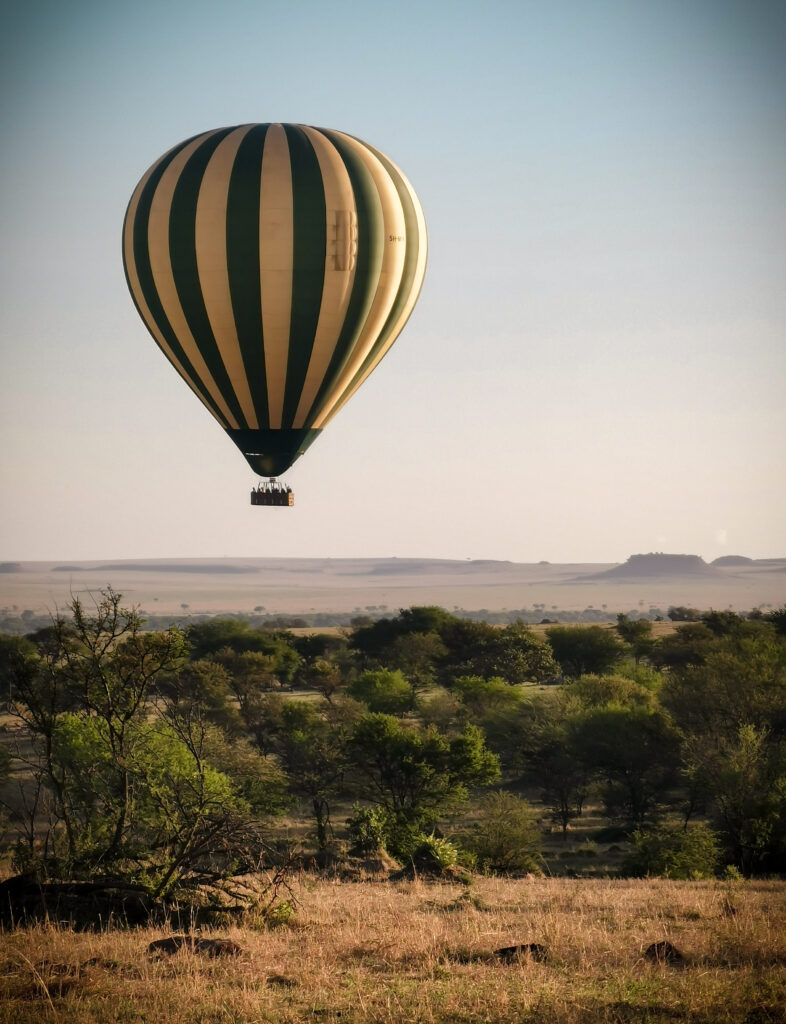
Hiking & Trekking
For active travelers, Tanzania offers plenty of great hiking and trekking opportunities. You can choose from several treks, depending on how many days you have. For a full trekking experience, you can scale Mount Kilimanjaro in 6-9 days. For a slightly shorter route, opt for Mount Meru (3-4 days). If you’re short on time you can climb Mount Ol-Doinyo Lengai (the holy mountain in Masaai) in 12 hours (midnight to noon).
Beach
Beach lovers can get their Vitamin Sea fix on the endless beaches of Zanzibar. Resorts vary from budget to luxury, so there is something for everyone. Check out which side of the island best suits your needs, as your beach experience will be very different depending if you stay North, South, East, or West. This is due to the massive tidal differences.
History
For those interested in ancient or pre-history, Tanzania boasts some of the oldest finds of the earliest humans in the Oldupai Gorge, which you can visit en route from Arusha to the Serengeti.
Culture & People – The Maasai
You can easily spot the Maasai people by their red, traditional dress style. They inhabit vast parts of Northern Tanzania (and Kenya). They are largely pastoralists and famous for their reputation as warriors. Having a very unique culture, there are several opportunities to visit local tribes in their “boma” (a village of traditional houses), and learn all about their customs and traditions.
If you’d like to experience their culture without stopping at a “touristy village”, a good alternative may be a stay at Original Maasai Lodge – Africa Amini Life. It is a beautiful, community-run Lodge, allowing us to fully experience the Maasai lifestyle and learn much about Maasai culture. Traditions, food, and activities are all against the backdrop of magical Mount Kilimanjaro & Mount Meru.
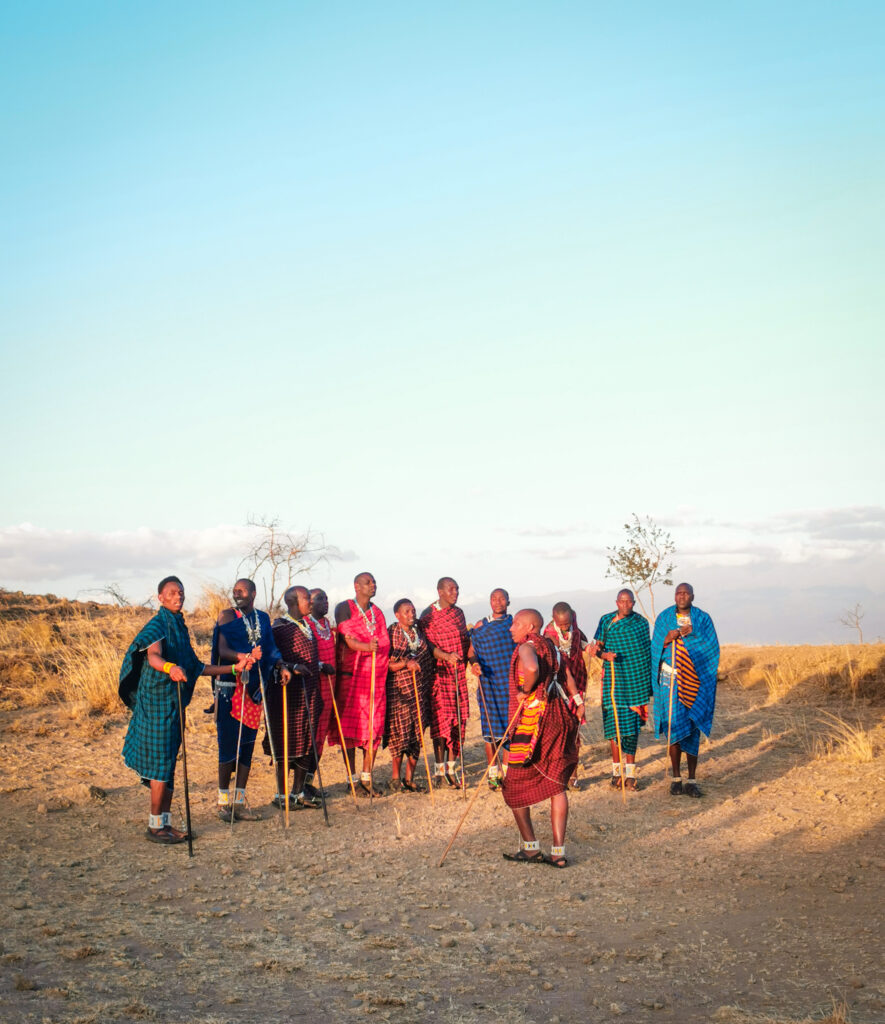
Other cool activities
Besides the above, there is so much else you can experience in Tanzania. You can go on sundowner-, nature-, or medicine walks, which teach you about healing plants and herbs. Coffee Tours, Banana Farm Tours (combined with a stay at this amazing hostel!), or Waterfall Tours (e.g. Arusha, Lake Natron) are equally interesting.
How many days do you need in Tanzania?
As Tanzania has so much to offer, I recommend at least two weeks for your trip. In the best case, you will even have three weeks or longer. Don’t underestimate the distances.
For safaris to the main National Parks in northern Tanzania, I recommend the following minimum stays:
- Tarangire National Park: 2-3 Days
- Lake Manyara National Park: 1 Day
- Ngorongoro Crater: 1 Day
- Serengeti: 3-4 Days
What is the best time to visit Tanzania?
The best time to visit Tanzania depends on the activities you’d like to do. As a rule of thumb, the best time to visit Tanzania is June to October, which is the high-/dry season. November to December & April to May are low season.
What time of the year is best for a Self-drive Safari in Tanzania?
The dry season (June to October) is when your chances to spot animals in the National Parks are highest, as they gather around watering holes. Furthermore, if you wish to witness the great migration (Calving season & Mara river crossing) you should best travel between December – March and August – September respectively. There are still smaller herds crossing in early-mid October. At the end of October-November, the herds cross back from Kenya into the Serengeti.
Is it safe to travel to Tanzania?
Yes, Tanzania is a safe place to travel to. If you follow some simple “common sense” rules, e.g. no driving at night, no walking outside alone after dark, and keeping your valuables out of view, nothing will likely happen.

Is Tanzania cheap for tourists?
Contrary to what you may think, Tanzania is not a cheap country to travel to. Tanzania is remote, and one of the best places for a safari worldwide. To support conservation efforts and as one of the main sources of income, National Parks charge high fees for tourists. No matter if you are traveling “budget” or splurging on some more luxurious lodges, Tanzania is not a low-budget destination.
One main cost driver: location of your accommodation
One consideration that will significantly impact your overall budget is whether you plan to stay inside national parks or outside of national parks on your self-drive safari in Tanzania.
If you stay inside the park, you will have all the perks of more time, beating the crowds, and being right in the center of the action. At the same time you need to consider that means you pay additional “park camping fees” & car entry fees (per night). These costs come on top of your accommodation costs.
No matter if you are staying on a public campsite (30 USD per night per person), private campsite (50 USD per night per person), or a lodge (60 USD per night per person), you will notice that your biggest self-drive safari expense in Tanzania will be fees and permits.
Lodges in Serengeti might already include that fee in the final price. Don’t forget to ask about this when you make your booking. Staying in a lodge, even if it is “budget”, you should keep in mind you will still be spending around 200 USD per night per person.

Sample Overview of Costs:
- Transit fees (via Ngorongoro Crater): 140 USD + 10 USD – Paid only once
- Serengeti Park fees: 60 USD + 5 USD in low season
- Accommodation fees: 30 USD
- Car rental fees: 30 USD (Considering a vehicle that costs 120 USD per day)
- Gasoline for 1000 km: 20 USD
Getting to Tanzania
Most will arrive in Tanzania via Air travel. The good news: you have many options regarding which airport to choose, depending on which has the best fares and what your exact itinerary looks like.
We flew from Frankfurt via Istanbul to Dar es Salaam (the Capital of Tanzania) and then hopped on an inland flight with Precision Air to JRO (Kilimanjaro International Airport). To get to Zanzibar we took another inland flight from Arusha Airport to Zanzibar and got a better-priced return flight from Zanzibar via Istanbul back to Frankfurt.
In a nutshell, for your self-drive safari in Tanzania, you can fly into:
- Zanzibar (ZNZ): often one of the cheapest airports, given the “holiday” character. Continue onwards with local airlines e.g. Precision Air
- Kilimanjaro (JRO): close to Mount Kilimanjaro, if you want to kick off your trip there
- Dar es Salaam (DAR): often a convenient airport, from which to fly onwards to JRO or ARK
- Arusha Airport (ARK): a smaller airport just outside Arusha City, which will be the best starting point for your safari if you plan to skip Mount Kilimanjaro.
Check these four options and see which is most convenient for your dates & prices. Another option might be to book a multi-leg flight (e.g. flying into JRO but flying out of ZNZ). Also, look for local domestic airlines to bring you from A to B.

Driving in Tanzania & Renting a car
While planning our road trip we found very little information on the internet about self-driving safaris in Tanzania, which made us a little uneasy sometimes in our planning phase. When we got there, we saw why: it is still quite uncommon to do this. Most people who visit, go on organized tours with a driver or driver-guide, rather than self-driving.
After doing our own self drive safari in Tanzania I can say it is an absolute paradise for road-tripping! At the same time, I wouldn’t recommend it to everybody, especially complete first-time self-drivers in Africa. More on this below, but sometimes a road trip in Tanzania can be “adventurous”. Not all roads are easy to drive, you need to plan ahead and need a little bit of patience and stress resistance.
For those who’d like to experience a self drive safari for the first time, I highly recommend starting in countries such as South Africa or Namibia, which are a little easier to navigate. For a detailed guide to planning your Namibia Road trip click here.
Now let’s get into details!
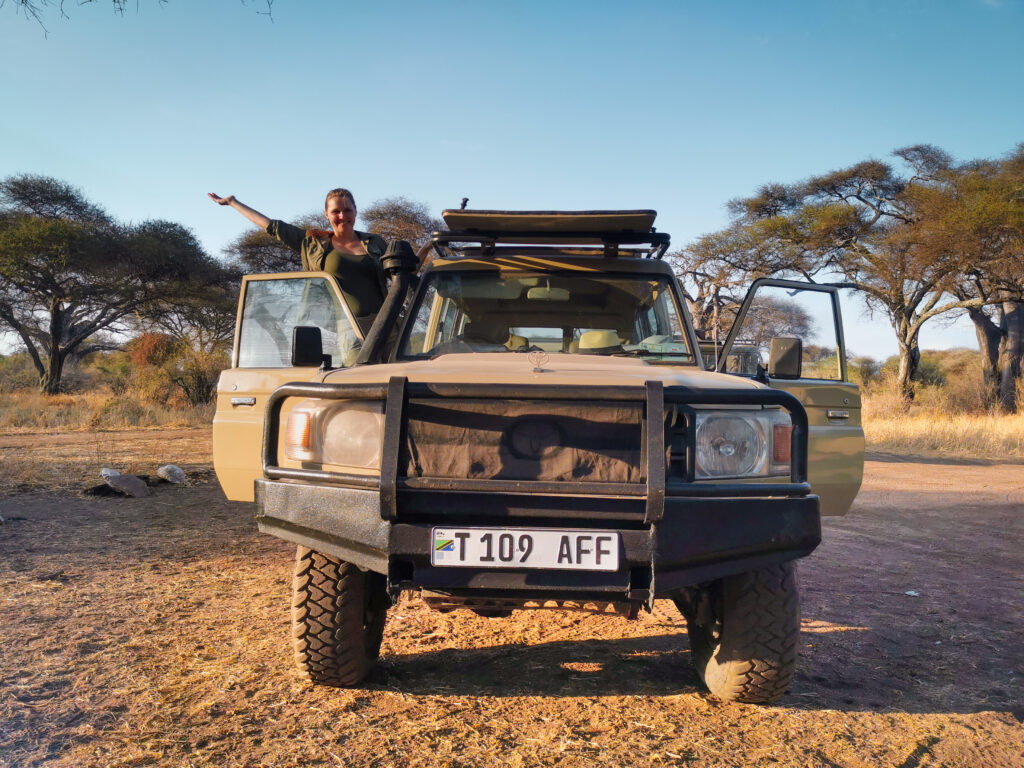
Can you self-drive on safari in Tanzania?
Yes! You absolutely can self-drive in Tanzania. However, there are a couple of things to keep in mind to make sure you have the best experience.
FIrs, some basics: In Tanzania, as in many African countries, you drive on the left side of the road. You need a valid international driver’s license to drive in Tanzania. To have the best experience on your roadtrip, make sure you get a 4×4 (4WD) car. National Parks only allow entry with a 4×4 drive car.
Can you self-drive Safari in Serengeti?
Yes, you can self-drive in the Serengeti. The Serengeti is huge, therefore it is important to distinguish between different areas of the National Park.
While it is very feasible to self-drive in the south & central Serengeti, we perceived the terroir of the Northern Serengeti to be more challenging. The road conditions were tougher and you need to know where to go. For instance, given that the migration occurs via various crossings along the long Mara River, it’s hard to know where “the action” will happen. Therefore, it’s helpful to have an experienced guide with you (e.g. we opted for guided Game drives in the north, which was very helpful).
Can you self-drive Safari in Ngorongoro Crater?
This was one of the parts of the road trip we were most nervous about beforehand. In a nutshell: Yes! You can self drive in the Ngorongoro Crater. The roads to enter and exit the Ngorongoro Crater are not tricky from a technical viewpoint (tarmac!). Don’t worry about this aspect. They are quite steep, but a good 4×4 car can handle it easily. There are, however, two things to consider:
- You may need to do a little bit of convincing the guards when paying for your entrance permit. They will tell you that you cannot self drive and need to take a guide. But this is not true. Stay resolved.
- There is high-cost factor involved in self driving the Ngorongoro Crater. In addition to the entrance fee per adult ($70.80), there is a vehicle cost of $295 that comes on top. If you go with a group, this fee is split up across more heads and is likely already included in your tour price.
Drive times for your self drive safari in Tanzania
Don’t underestimate distances and drive times in Tanzania. Many tours head straight from Arusha to Serengeti which is “only” 255 km but will take you 9-10 hours. Only part of the road is tarmac (from Arusha to Lodoare Gate – entry to Ngornongoro Conservation Area). Once you enter NCA, roads are narrow, gravel, and not in good shape. From NCA it will take you another around 3 hours to reach Naabi Hill Gate (Serengeti).
Therefore, I recommend splitting your trip from Arusha to Serengeti. Instead, make the journey exciting by interspersing it with visits to the National Parks on the way. Visit Tarangire National Park, Lake Manyara National Park, followed by Ngorongoro Crater and finally the famous Serengeti. Below is a summary of drive times you can expect.
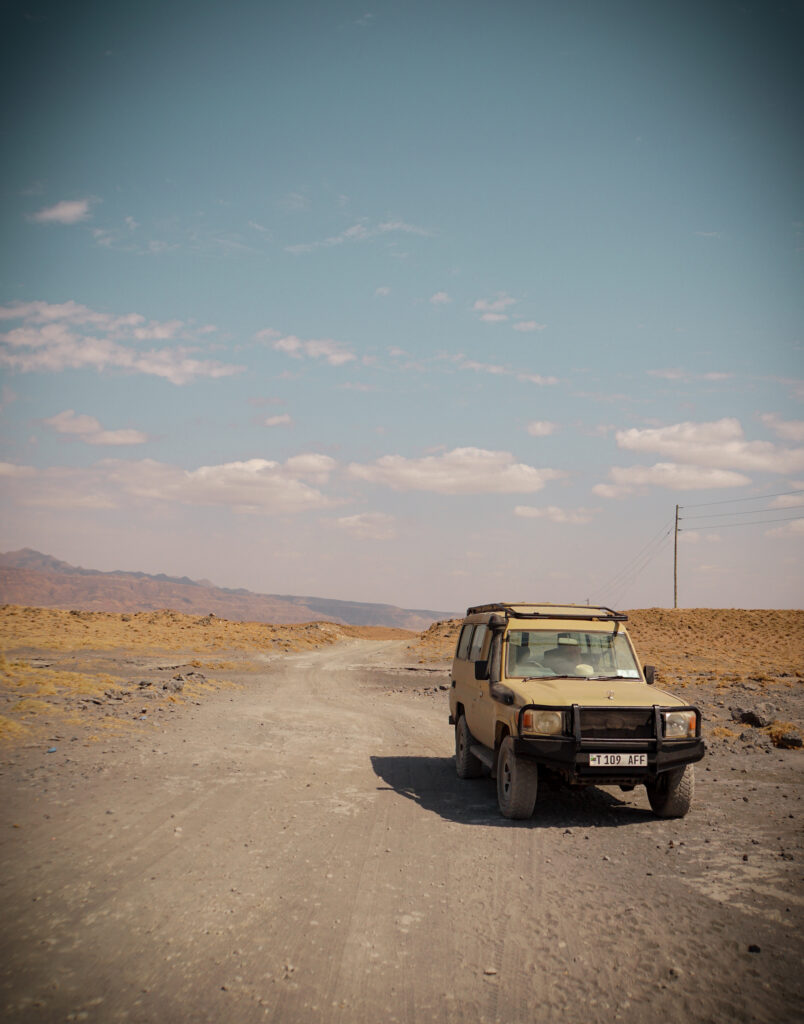
Summary overview of drive times:
- Arusha to Serengeti (Seronera): 315 km (ca. 9-10 hours)
- Arusha to Karatu: 140 km (ca. 3,5 hours)
- Karatu to Loduare gate (entrance to NCA): 15 km (ca. 30 min)
- Loduare gate to Ngorongoro crater entrance: 15 km (ca. 1 hour)
- Ngorongoro Crater entrance to Naabi Hill Gate (Serengeti entrance): 85 km (ca. 3-3,5 hours)
- Naabi Hill gate to Central Serengeti (Seronera): 60 km (ca. 1-2 hours)
- Seronera to Lobo Ranger post: 80 km (ca. 2 hours)
- Seronera to Kogatende: 160 km (ca. 4-6 hours, depending on road conditions)
- Kogatende to Klein’s Gate: 70 km (ca. 2-2,5 hours)
- Klein’s Gate to Lake Natron: 160 km (ca. 4-6 hours)
- Lake Natron to Mto Wa Mbu: 110 km (ca. 3-4 hours)
- Mto Wa Mbu: 115 km (ca. 2-2,5 hours)
Is it safe to rent a car & self-drive in Tanzania?
Short answer: Yes, it is safe.
Longer answer: Yes, but only if you keep some things in mind:
- Make sure you follow the “common sense” rules above.
- Following road safety instructions. Especially: don’t speed, don’t drive at night, and don’t drive recklessly. Road conditions are sub-optimal in many parts of Tanzania (especially in the Serengeti and around Lake Natron). This makes accident-proneness or the likelihood of getting a flat tire or similar very likely.
- Rent a 4×4 car with the right equipment (spare tires & co.). Keep your gas tank full and always have lots of water on you.
Car Rental Choice: Roadtrip Africa
We did lots of online research and compared many providers. Finally, we selected “Roadtrip Africa” for our self drive safari in Tanzania. They had helpful information to help plan the logistics of the road trip and a responsive team to answer any questions. We selected a Toyota Landcruiser Hardtop with a pop-up roof: perfect for safari.
Pros:
Overall, we were quite happy with our choice. They picked us up at JRO-Airport with our car, and briefed us on how to drive, how to use the roof, how to fix a flat tire, etc. They have unlimited mileage. Other companies, e.g. Tanzanian Pioneers / Serengeti Select Safari have you pay $1.30 per km, for at least 100 km per day. Furthermore, they helped us arrange all permits in advance for a small fee, which took away some headaches. They have 24-hour assistance and know a car mechanic in every part of Tanzania, which was helpful.
Cons:
Unfortunately, there were also a couple of downsides to our rental experience. The fridge we rented did not work (and it took several weeks chasing to get a refund for this). The car was old (250,000 km) and did not have air conditioning. Although this is done to prolong the car’s lifespan, it was not ideal in some places like Tarangire National Park (which was extremely hot but you could not open windows because of tsetse flies).
Furthermore, we felt the car had a “lifespan” of around 2 weeks. After this, during our Lake Natron part of the journey, the car had many issues. A pipe leaked clutch fluid and broke, which means our car broke down in the middle of nowhere between Kleins Gate & Wasso. The front of the car became jammed and our spare tire broke off the back of our car in the sand at Lake Natron.
Despite these difficulties, we would rent with them again for our next self drive safari in Tanzania.
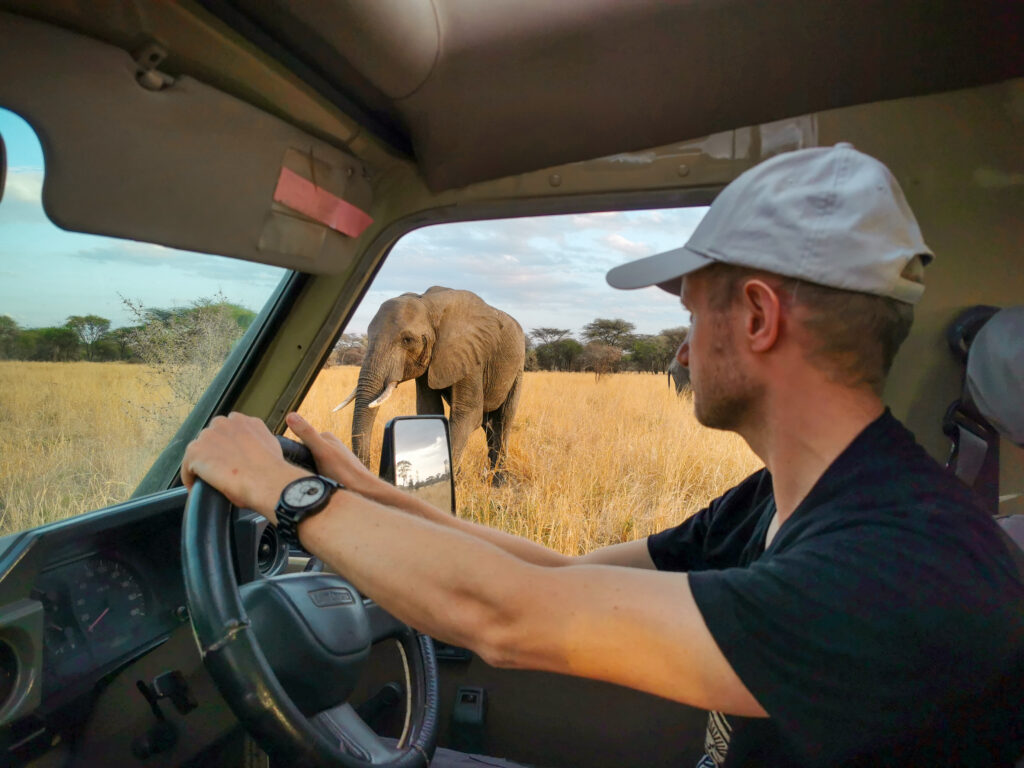
(Car) Equipment & Tips for your self drive safari in Tanzania
Below you will find a couple of helpful “rules of thumb” to keep in mind when selecting your car:
- Make sure you get a 4×4. This is a “must-have”. Many parks don’t let you drive in with a Royota RAV.
- Make sure you have 2 tanks (e.g. 2x 80L). Always start with the sub tank and then work your way towards the main tank. This is especially important in Serengeti, with a limited amount of gas stations. Fill up whenever you can.
- Have at least 2-3 spare tires.
- Hardtop with pop-up roof is a benefit but not a “must-have” on your Safari. It was helpful to enable a good view of the animals during safari. However, given it was just the two of us, we could have done without this, as we mostly opened the roof of the driver’s / front seat (this was very helpful).
- A fridge is helpful to keep your water and drinks cool (if it works ;-)).
How much does it cost to rent a car in Tanzania?
For our Landcruiser Hardtop we paid a total of €2,363 for 16 nights.
This included a fridge as well as the costs to arrange our permits to NCA & Lake Natron.
Traffic Regulations: Mind the traffic police!
One big takeaway from our trip: mind the traffic police! While you may think traffic rules are more relaxed in Tanzania, this is not the case. Traffic police are all over (there are roadblocks in almost every village ), and have a keen eye on traffic violations.
Make sure you:
- Stick to the maximum speed limits of 25 km/h inside National Parks, 50km/h in cities & 80 km/h on highways;
- Don’t surpass when there is no dotted line;
- They check if you stop at red traffic lights. Although this is self-explanatory, I still mention it because some locals don’t (esp. in downtown Arusha). Even if you see locals not following this, don’t repeat it! (My husband was taken to a police office in Arusha where we had to pay a fine. Waiting in the car alone for my husband to return was a little unnerving).
The fine for any infringement is 30,000 TZS. It sums up. We had to pay this 3 times, unfortunately. Ask to pay this via card, not via cash (to battle corruption). This way the fine goes directly to the state & not the officer’s private pocket.
Navigating Tanzania’s (Off)Roads: maps.me & Paper Maps
Google maps is useless for navigating during your self drive safari in Tanzania. Do not rely on it, as it has wrong information and wrong roads drawn in! Rather use maps.me. It is a much better option for navigating – both for roads and in national parks (via GPS).
As electronics can fail, we additionally used physical paper maps by the “Harms IC Verlag“. They have maps of Serengeti, Masai-Mara, Ngorongoro, Lake Manyara, Tarangire, Kilimanjaro, Arusha, all of Tanzania and Zanzibar. These were very helpful when navigating the National Parks and provided some additional orientation in parks (especially Northern Serengeti). Maps.me has tiny roads (which often are not roads) drawn in as well, which can sometimes be a little confusing. The paper maps show the main, official routes. Furthermore, they have many Campsites and lodges drawn in.
Self Drive Safari Tanzania: Travel Planning
So, you’ve settled on visiting Tanzania and doing a self drive safari – great! Below are a few more pointers to help you prepare for your trip.
Visa & Entry Regulations
You require an international passport to travel to and enter Tanzania. Your passport needs to be valid at least 6 more months after your exit date.
Furthermore, you will most likely need an entry visa. You can get an electronic visa, which you need to pay online and bring with you printed out on an A4 sheet. The processing time for this is at least 2-4 weeks, so make sure you plan enough time. Please check your own country’s authorities’ guidelines on this.
In some cases, you have the possibility of getting a “visa on arrival”. However, it is not guaranteed that you will be granted this and you will need to consider unpredictable waiting times. Costs are $50 for each Visa, payable by cash (USD) or credit card.
Vaccines & Medication
Please speak to your doctor, about which vaccines they would recommend getting before traveling to Tanzania. In our case, our general practitioner recommended Hepatitis A & B, Cholera and Malaria prophylaxis. It may also be helpful to look into Dengue Fever, transmitted by Aedes mosquitoes (active during the day).
Since October 2023 there has been an increase in documented cases of Malaria in Zanzibar. In all parts of Tanzania, there is a high risk of Malaria year-round, incl. cities & national parks. Therefore malaria medication is highly recommended. Talk to your doctor or pharmacist and plan enough time to build up protection in advance (e.g. Malarone). Furthermore, I recommend you bring a good mosquito repellent (with some DEET component).
Generally, there is no mandatory yellow fever vaccination necessary for Tanzania. This is also not required if you transited through a yellow-fever country, as long as you didn’t leave the airport AND transit was shorter than 12 hours. If you are entering from a country with yellow fever (e.g. Kenya), you will need a yellow fever certificate.
COVID
Although COVID-19 thankfully no longer poses a huge threat to international travel, make sure you get up-to-date about information and regulations currently in place in Tanzania.
Travelers may need to conduct a health screening (e.g. temperature measurement), or possibly do quick tests (free of charge).
Planning your Route: Self drive safari in Tanzania
Before you plan your route, you should decide how many days of Safari you want, if you’d like to see Mount Kilimanjaro and if you want to stop by Zanzibar at some point. If you have at least 2+ weeks of time, I highly recommend a mix of all three of the above. If you have just two weeks, I recommend skipping Mt. Kili and instead doing a safari in Tanzania mainland & perhaps a visit to Zanzibar.
Decide which national parks you’d like to visit and plan your route accordingly. To see all big-4 national parks (e.g. Tarangire, Lake Manyara, Ngorongoro Crater & Serengeti), I recommend you have at least 2 weeks for safari only. This ensures you are not under time pressure, have enough drive time and plenty of time in the parks themself.
If you plan to visit Serengeti National Park from Arusha and drive back the same way you came, keep in mind that you need to pay the NCA fee ($70 pp plus $20 per vehicle) twice – once on your way there, once on your way back. To avoid this (and see something new on the way back), I’d recommend going off the beaten track via Serengeti North and Lake Natron.

Permits – NCA & WMA
NCA
To enter the Ngorongoro Conservation Area (NCA), you need an entrance quote, before paying the fee at the entrance gate (Lodoare Gate). This can either be done at their office in Arusha, or, more conveniently, you can get this pre-arranged by your rental agency.
For other parks, e.g. Serengeti, Manyara or Tarangire, you can pay directly at the park entrance via credit card (no cash). The fee is per person per day, per car and per night.
WMA
Lake Natron is part of a Wildlife Management Area (WMA), i.e. countrywide conservation areas established by TAWA (Tanzania Wildlife Management Authority), to help local communities. You will need to get a WMA permit when visiting Lake Natron. This can be paid at the TAWA office in Arusha, or arranged in advance by your rental car agency or hotel. There are four types of fees you need to expect when traveling to Lake Natron:
- Gate Fee: $35 per person, when arriving from Serengeti or from Arusha/Manyara/Longido. This can be paid in USD or TZS, ideally in cash.
- Vehicle entrance fee: 17.700 TSH per car
- Camping fee: $23.60 per night / Concession fee: $17.70 per person per night when you stay at a lodge inside Lake Natron WMA. Usually this is managed by your lodge and incorporated into your hotel bill.
- “Wildlife activity fee”: $11.80 per person (for activities – e.g. Guided visit to Lake Natron shores or a day hike to Engaresero waterfall. Needs to be done with a guide). This can be paid to the community office.
Accommodation
Your accommodation choice during your self drive safari in Tanzania will depend on two factors: your budget and whether you stay inside or outside national parks. These factors are also closely related to each other.
In some cases (e.g. Serengeti or Tarangire) it makes sense to stay inside the National Parks. They are very big and it will be difficult for you to see most of it, if you need to re-enter the park daily via the main gate.
For smaller parks such as Lake Manyara or Arusha National Park, there are many options for staying outside the park in Mto Wa Mbu or Arusha.
For Ngorongoro Crater, you can go for a budget-friendly option by staying in Karatu (or anywhere outside Lodoare Gate) and then head into the Ngorongoro Crater for a day trip. However, note that you will miss the early sunrise drives this way. If you stay in Karatu, you either need to get up really early (4 – 4:30 AM) or make it into the crater only around mid-/late morning.
Public Campsites
You do not need to book these in advance and can pay for them at the park gates. They have showers and toilets & you stay there with other campers. These camps can often get very full in peak season.
Private or “special” campsites
A better option is private campsites or “special campsites”. These cannot be booked yourself, but only through a special booking system. You can ask your car rental company to book them for you in advance or you can book “remaining spots” at the NCA office when you are in Arusha (no guaranteed availability). Many special campsites are often booked for an entire season by lodges.
Special campsites are in the wilderness with no amenities, e.g. no toilet or running water. Keep this in mind when planning. Please also keep in mind that these can be hard to find. They are often not well signposted or only have one sign leading to the approximate location. Speak to your rental agency for exact instructions, or ask park rangers (e.g. at the entry gate) to help.
Tented Camps
Many tented camps inside National Parks, offer individual tents without much luxury, but all necessary amenities such as toilet and shower. These may be a good budget-friendly way to stay within the parks.
Luxury Tented Camps or Lodges
These are the up-scale options within the parks. They are at prime locations and do not leave any wishes unanswered. Expect to pay €400 – €800 per night.
In the Serengeti you will also find “Migration Camps”. These put you at a prime spot to witness the Great Migration, as they move with the Migration streams throughout the year.
Language: Know some basics in Swahili
As in many countries, knowing some basics before arrival and using these will open many doors. Below some of our most-used and favorite phrases to prepare for your self drive safari in Tanzania:
- Jambo: hello
- Kwa heri: good bye
- Asante (sana): thank you (very much)
- Karibu (sana): you’re (very) welcome
- Lala Salama: good night
- Fundi: car mechanic ;-). I hope for you, that you will not need this. But when embarking on a self drive safari in Tanzania, chances are it will be an adventure. And with adventure come unforeseen (car) circumstances. So a Fundi might come in handy at some point during your road trip!
- Pole pole: slowly, slowly. This is a mantra on Tanzania’s roads. Many roads are in bad shape (therefore, the only way forward is very pole pole). You will also find that to enjoy all the wonderful things Tanzania has to offer, the best way is to “slow travel”.
- Hakuna Matata: not only does it mean “no worries” it should also be your Motto for the trip. A self-drive safari in Tanzania may be one of the most memorable experiences, but also comes with adventure and unexpected twists. Keep in mind: even if you get stuck or something goes not according to plan – embrace it and be grateful for the experience. In retrospect, you will look back and laugh!
Packing for your self drive safari in Tanzania
When packing for your self drive safari in Tanzania pack for both warm & cold temperatures, focus on functionality, and keep in mind the different activities you have planned. Below are some of the most important takeaways from our trip:
- It is advisable to travel with a backpack or a duffle bag. Ideally something you can easily carry on your back and don’t need to roll. To get to your tent/lodge you may need to walk over grass, dirt or uneven ground so it is not convenient to pull a suitcase. Furthermore, it is easier to put things in your trunk in duffle bags or backpacks and you don’t need to worry about cracks.
- Light, loose safari clothing: ideally in colors such as beige, khakhi or olive green (mirroring the landscape). AVOID dark clothes (especially in Tarangire & Serengeti National Parks! This attracts tsetse flies!
- Some warm clothes (e.g. fleece, warm pants), as it tends to get very cold at night (especially Ngorongoro Crater)
- “Heat it” smartphone mosquito buzzer. Game changer for reducing the itch on those bites (you will get them anyway).
- Insect repellent: we bought some with DEET – this is more effective than the stuff you can get in supermarkets.
- Binoculars: this was very handy for our safari adventures. It helps with animal spotting and is super fun to get a closer look at the animals. We were really happy with our Celestron 71406 TrailSeeker 10 x 42.
- Hat: very helpful, even when you are in the car.
- Sunscreen: make it strong sunscreen, e.g. 50 SPF. The sun is very strong (especially in Zanzibar and on the beach) so protect from the rays at all times.
Photography equipment
- Camera: bring. your. camera. There will be so many occasions where you will capture shots to remember for a lifetime. I love my Sony Alpha 6000 series camera, which gets great shots but is still lightweight and perfect for travel.
- Telephoto Lens: highly recommended for safari, to make sure you can really zoom in on the animals. My lens had a zoom range of 70-350mm with f/4.5-6.3, which was perfect to get the shots I wanted.
- Wide angle lens: to the amazing landscapes and to get some shots of the night skies. Pack a wide angle lens (e.g. 12mm) with high light sensitivity, e.g. f/2.0. I recommend this one.
- A Small tripod is handy during dusk to capture animals or for star photography. I was very happy with this one.
- Camera cleaning kit. It is very dusty on Tanzania’s roads, so bringing a lens & camera cleaning kit is essential to ensure your photos stay dust-free. (e.g. this one).
- Camera and lens protection “sleeves”. The roads are very bumpy. You may not always re-pack your camera after use, especially given the many beautiful motives on the way. Therefore, I highly recommend protective sleeves for your camera and your lenses. They provide some extra protection even without a fancy camera backpack.
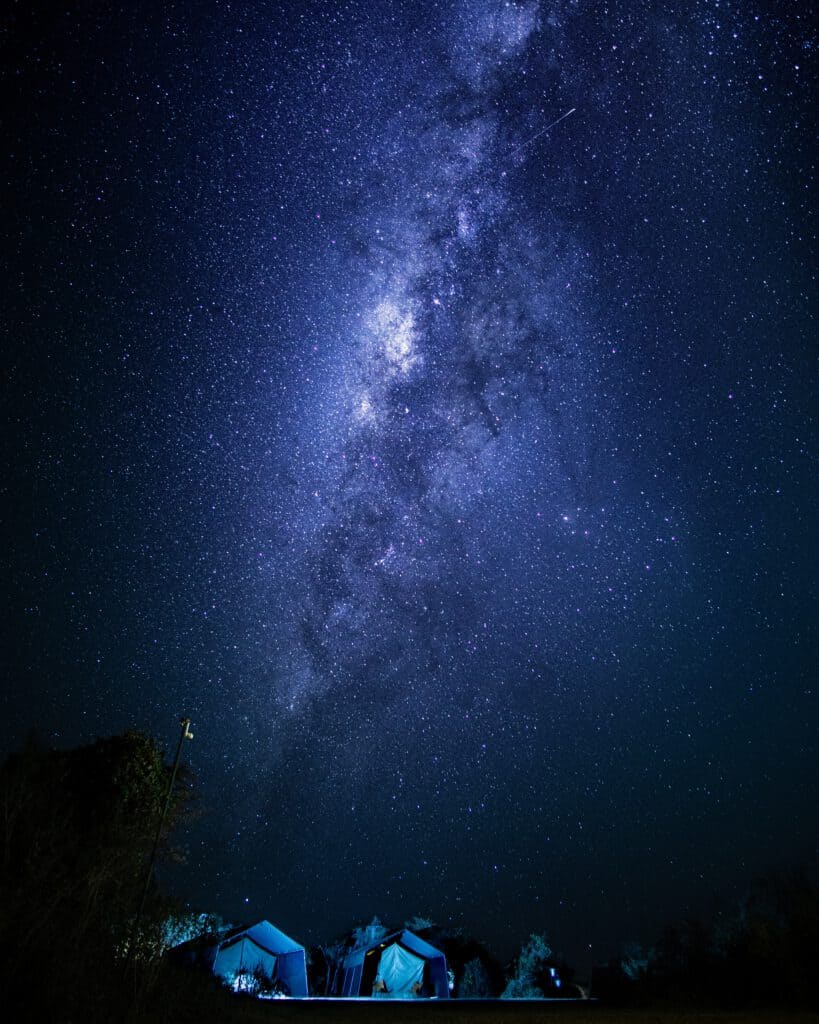
Welcome to Tanzania! First Steps upon Arrival
Luggage
Depending on your itinerary, there are some things to note about baggage. Our flight came in from Istanbul via Dar El Salaam, however our final destination was JRO Airport (Kilimanjaro). If you have a domestic connecting flight within Tanzania, you need to pick up your luggage at DAR Airport and re-check it. You cannot check it through to your final destination, even if you have the entire leg booked as one trip.
In DAR airport, you will most probably arrive at international terminal 1. If you have a domestic transfer you will need to take a 5-minute walk to Terminal 2, which is the domestic terminal. There you will need to re-check your luggage.
If your luggage gets lost, claim it at the airport where it was lost, not your final destination. This will make tracking easier.
Get a SIM-Card
For a local SIM card I highly recommend getting Vodacom. You can buy this at a kiosk directly outside JRO airport. The rate we got was 11 GB for 30 days at 20 USD, which was a great deal. When getting the SIM card you need to give your fingerprintes and show your passport.
Retrieving cash at ATM
At most hotels and bigger, touristy restaurants you can pay with credit card. However for smaller places, shops etc. you may need to pay in cash. Also, sometimes with patchy connectivity in some parts of Tanzania, payment machines do not always work. Therefore, make sure to have some back-up cash on you at all times.
Please note: Many cash machines do not take debit cards. Make sure you bring a credit card with you, which works for most international ATMs. The widest acceptance is VISA.
Basics to have in your car for your self drive safari in Tanzania
Once you hit the road, I recommend you stop by a store for some shopping. In smaller villages you will not find a wide variety, but basics like soap, toothpaste etc. Make sure to grab some snacks and plenty of water to keep in the car. Especially when you are in national parks, this is extremely important. It gets very hot and its important to stay hydrated. From experience, I also recommend you have a roll of toilet paper in your car at all times (as rest rooms on official picnic sites are not to be found every 5 minutes). You can even bring this from home. Make sure you also have a trash bag in the car, to keep your litter and trash when you arrive at your hotel or a central trash place.
Next, I’ll cover my recommended 3-week Self Drive Safari Tanzania Itinerary.

Our 3-Week Self drive Safari Itinerary in Tanzania
1. Mount Kilimanjaro Area
Before embarking on our Self drive safari adventure in Tanzania, we wanted to check out Mount Kilimanjaro area. We thought long and hard if we wanted to climb Mount Kilimanjaro. Ultimately, we decided against it on this trip. We wanted to focus on Safari. A proper scale of Mt. Kili takes you at least 7-8 days, if you plan plenty of time for elevation gain to avoid altitude sickness. Some providers offer 5 days, but the rate of failure is very high. With arrival and departure days, we did not want to spend ~10 days for Mt. Kili.
Instead, we opted for a combination of exploring the area and spending one night in a beautiful, community-led Lodge to learn about local Masaai culture (with Mount Kili as a backdrop).
Pick-up & settling in
After arriving at Kilimanjaro Airport (JRO) early morning, Roadtrip Africa waited for us in the parking lot with our Landrover. Pick up at JRO airport (vs. ARK Airport) is tied with a small extra fee, as JRO airport is further out of Arusha.
We received an induction of the car (e.g. functionality, pop-up roof, etc.), got our SIM Card, retrieved some cash from the ATM and hit the road 1-1,5 hours after landing.
The road to Kili offered a good start to the “drive” feeling of Tanzania. The streets were tarmac initially and passed some typical Tanzanian cities & villages, Boma Ng’Ombe, Sanya Juu and Ngare Nanyuki. En route we picked up some basic groceries (e.g. water, snacks, soap & toothbrush, as our backpacks had been left in Istanbul airport).
After Ngare Nanyuki the road became gravel and we navigated with maps.me which was helpful. What was initially gravel road turned into small gravel paths and we were glad when we saw the first signposts leading us to the lodge. Upon arrival in the late morning, we were greeted with cheerful Masaai songs, hot coffee, and homemade biscuits – a perfect welcome!
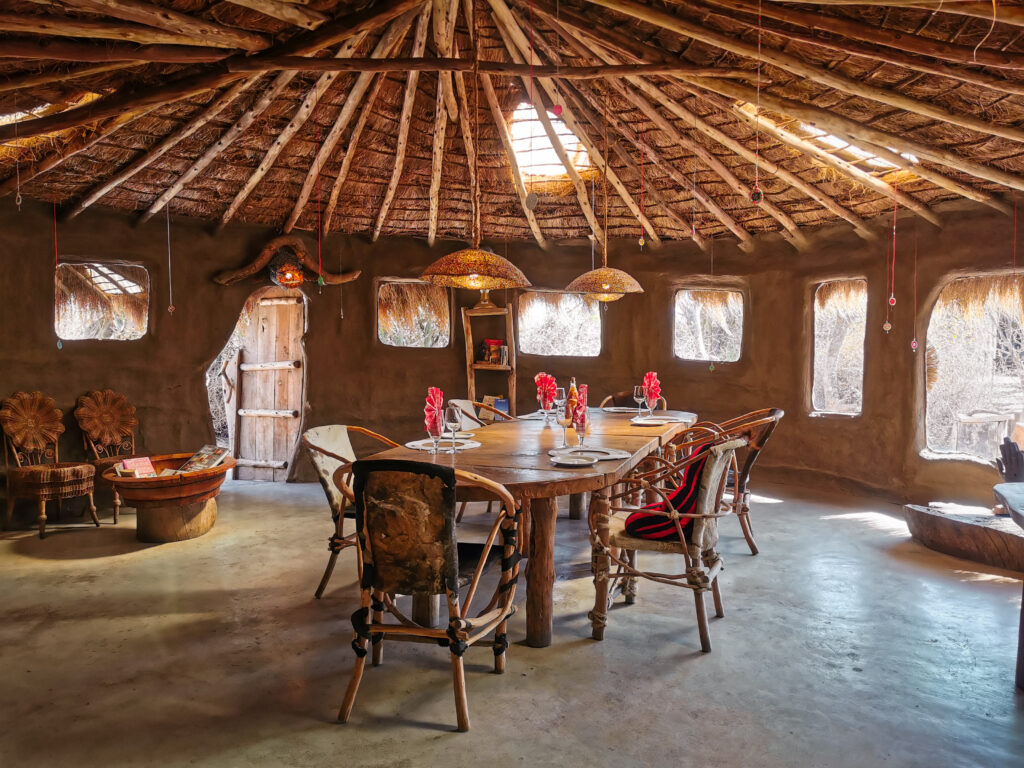
Our stay in Mt. Kili area
We checked in our rooms at noon and rested a couple of hours before heading out on a nature walk in the afternoon. We saw the surroundings of the lodge and walked close by giraffes. Our Masaai guide explained interesting information about local flora & fauna and we got beautiful glimpses of Mount Kilimanjaro & Mount Meru.
In the late afternoon, we got a cold drink in the bar and participated in fun, cultural activities that the lodge had planned for its guests. They did some spear throwing and traditional singing & dancing with a sundowner & cold beers. Although we are not huge fans of such “cultural touristy shows”, this was extremely well done and enjoyable! Afterward, we sat by a cozy campfire and got a chance to ask about culture, history & customs. After dinner, we were treated to a beautiful, starry sky.
In the morning we were greeted by coffee & biscuits in front of our Boma (traditional Masaai house). After a hearty breakfast in their restaurant, we walked around the property, enjoyed the views, packed up, checked out, and headed back out. In retrospect, it may have been more relaxing to stay here for two nights, as it’s a really beautiful area with many different kinds of activities. Overall a great way to experience Mount Kili and get a good first feel for Tanzania.
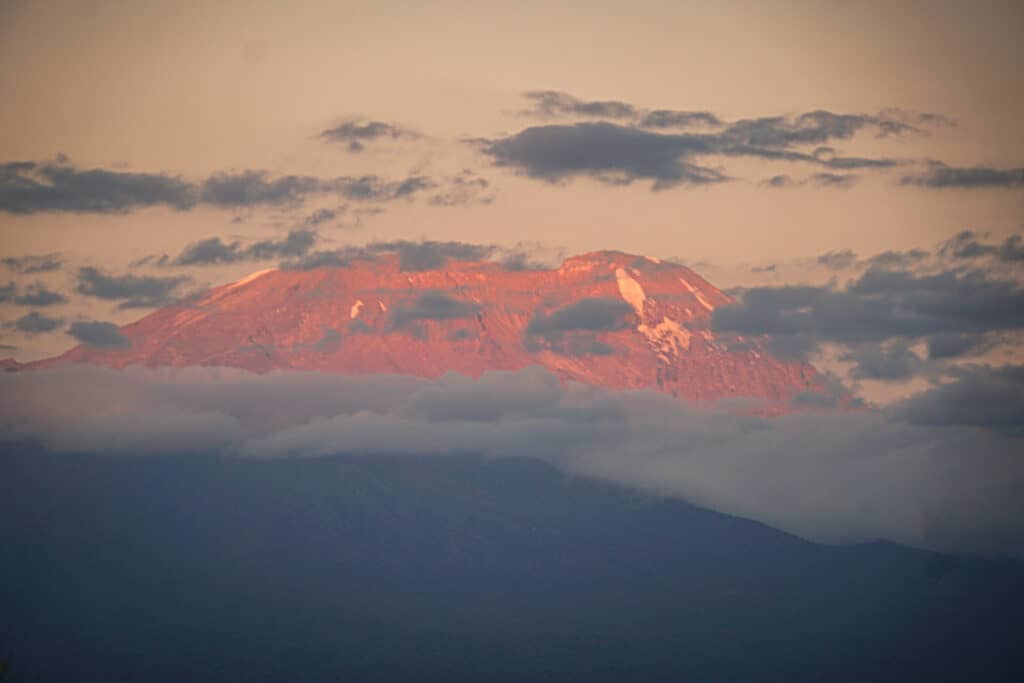
Next up: last prep before kicking off your self drive safari
From here you have several options. You can head back via Arusha National Park, take a tour of Materuni Waterfall & do a Coffee Tour. Or head to Arusha and stay there for a night (e.g. at Banana Farm Eco Hostel) before heading to Tarangire National Park.
We stayed a night at Wildlife Residence in Maji Chai, which proved perfect for us as we could pick up our lost luggage at the airport before heading into Arusha. Before heading to Tarangire we picked up our NCA / WMA permits from the Roadtrip Africa office in Arusha.
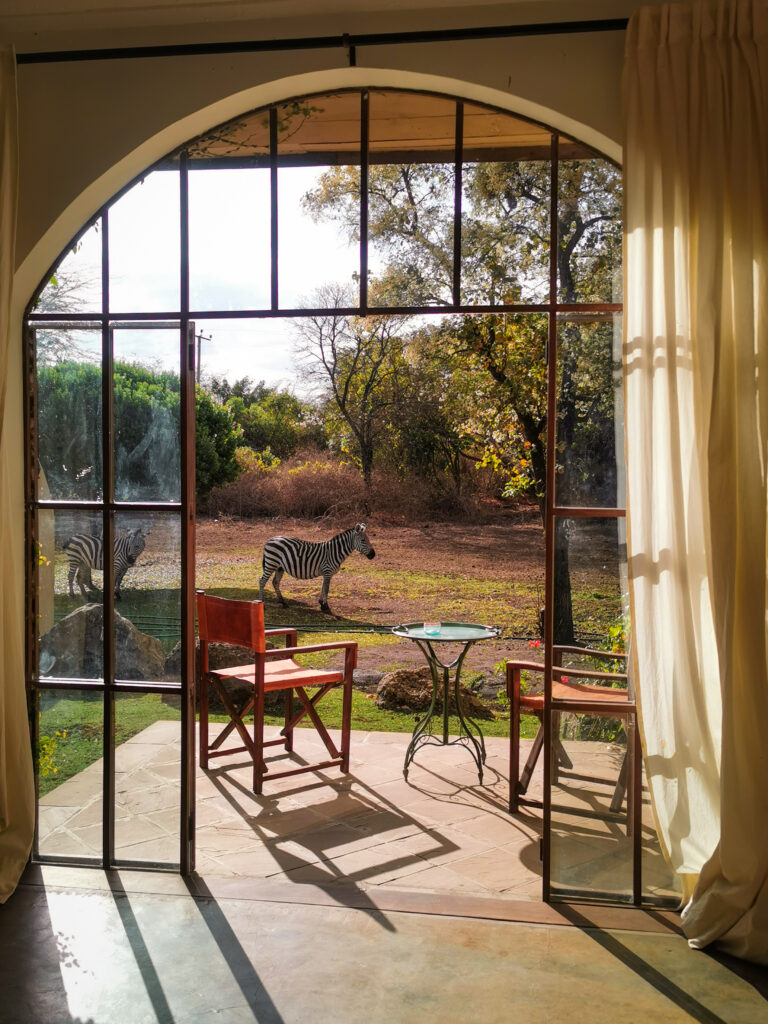
2. Tarangire National Park
Tarangire (tara = river, ngire = warthog) has been an area of conservation since the 1980s. This National Park is famous for its swamps and wetlands, which are among others breeding grounds for many birds. Furthermore, it is known for its Baobab trees & exceptional elephant sightings. Tarangire National Park is part of a larger ecosystem of water that “migrates” from Amboseli NP (in Kenya) & Serengeti NP to Tarangire. This means, there is often still water left in Tarangire, when other areas have been dry for some time. With this movement, animal herds migrate to Tarangire (e.g. elephants) making for spectacular viewings.
Besides this fascinating natural scenery and great animal sighting opportunities, Tarangire National Park has a downside. It is known for the myriad of Tsetse flies. These are due to the many buffalo in the park and its abundance of water. They are very annoying and won’t stop biting even when swatted (even when spraying yourself with DEET repellent). Unfortunately, they can also transmit the African sleeping sickness. However, they rarely pass it on to humans! According to some blogs, the only thing that seems to work is “Dettol” which you can find in supermarkets. However, we did not try this. Another tip: avoid wearing black or blue (even inside the car), as they are attracted to these colors.
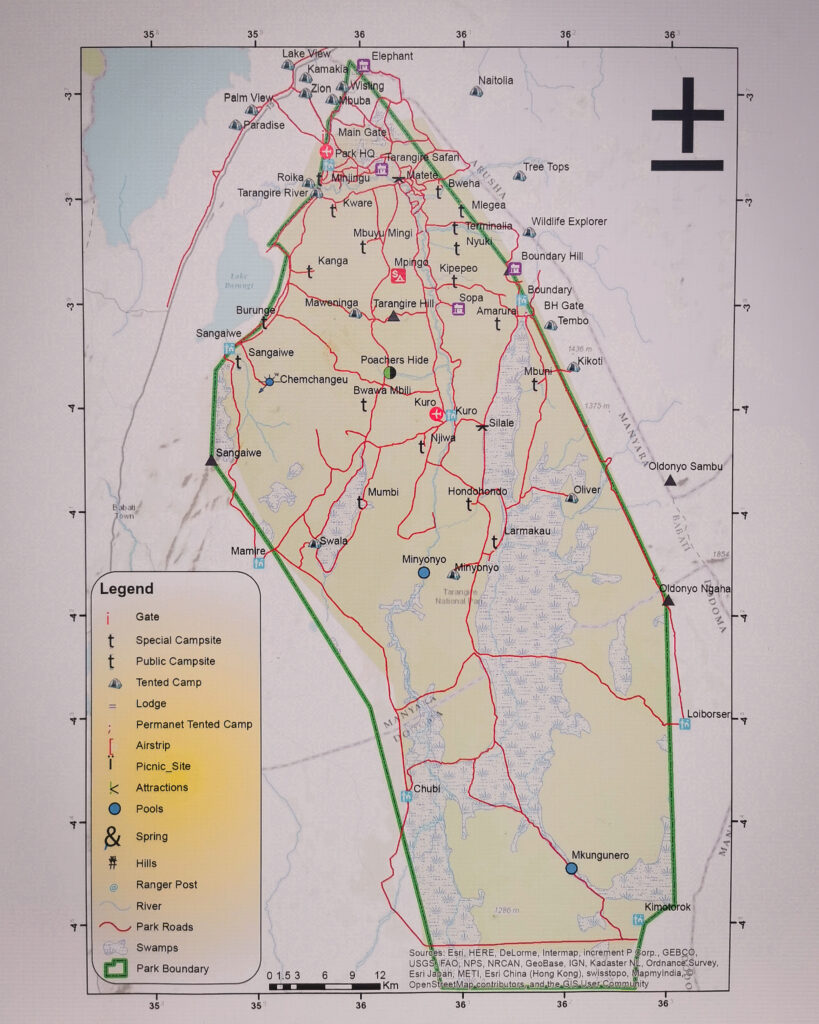
Practical Tips
Tarangire NP spans a very large territory. To maximize your safari experience, I recommend staying here for two nights, if possible inside the park.
We stayed in Baobab Tented Camp (which was located at Kanga Special Campsite/Kanga Area Seasonal campsite). It had really great value for money. While not being super luxurious, it had everything we needed, a great location inside the park and delicious food. Furthermore, the staff was super nice. It takes 1-2 hours to get there from the main gate, so make sure you plan enough buffer for arrival time.
Our favorite parts of Tarangire were around Silale Swamp where we saw large elephant herds, many different bird species, etc. In our 2,5 days / 2 nights there, we covered maybe 30% of the park (tops!) – don’t underestimate distances. Near Tarangire River (Lemiyoni picnic site) there are beautiful views into the vast distances of Tarangire NP. Beware of monkeys here – several people got their lunches stolen!
We had originally considered exiting the park through the southern gate, to avoid traveling the same road twice. We were discouraged from doing this by the staff from Baobab Camp in the planning phase. Once we arrived they explained that the roads south of Tarangire NP towards Lake Manyara were in bad shape. There are often broken bridges, you get ahead really slowly and would lose an entire day “on the road” for a distance that would otherwise take 1,5 hours.
Insider Tip
A new bridge was built over the Tarangire River a little south of the original crossing. This was not yet indicated on maps.me. Make sure you ask about this at the entrance Gate. It can save lots of time on your drive to get to the other side of the park (especially when staying at Baobab Camp).
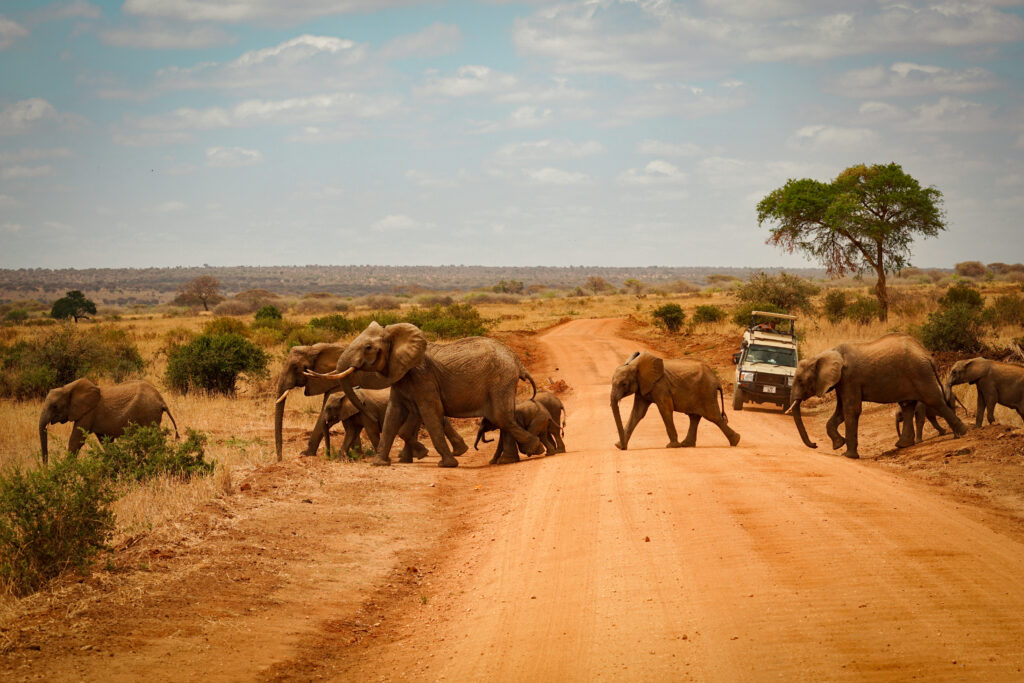
3. Lake Manyara National Park
Lake Manyara NP is much smaller than Tarangire NP and Serengeti. It is known for its location on the shores of Lake Manyara, where you can see hippos & birds & the Great Rift Valley Escarpment on the other side. In terms of ecosystem, Lake Manyara NP has groundwater coming from the fertile Ngorongoro Highlands. The Escarpment is covered by dense forests, fed by groundwater, which capture the moisture from the air and channel it back down to the park. The Lake is a large soda lake (similar to Lake Natron) and you can witness thousands of flamingos and pelicans breeding here. They often travel the distance between Lake Natron and Lake Manyara in one day for feeding.
Furthermore, Lake Manyara NP is known for its famous tree-climbing lions, a behavior not usually witnessed in other parks. Unfortunately, we did not see any, but maybe you will get lucky!
What stuck with us were the many, large troops of monkeys found inside the park, especially near the entrance gate. It was really fun to watch them, with their many babies.
Entering this NP feels a little like driving into Jurrasic Park. The entrance Gate, the lush, forests, and its roads have a very different “feel” than the other parks.
Insider Tips
- The dense forest canopy on some parts of the road made it more challenging for us to spot wildlife. Self driving is easy inside this park, however, it might be useful to get a guide to help you spot well-hidden animals.
- There is one main road leading through the park along the shore with some minor branch out into the forest. You can get through the park pretty well in one day. In my opinion, 1 day is enough.
- In terms of accommodation, it is not necessary to stay inside the park. The park is small enough that you can see mostly everything within a day from the Main Gate. There are plenty of great accommodation options for all budgets in Mto wa Mbu and its surroundings.
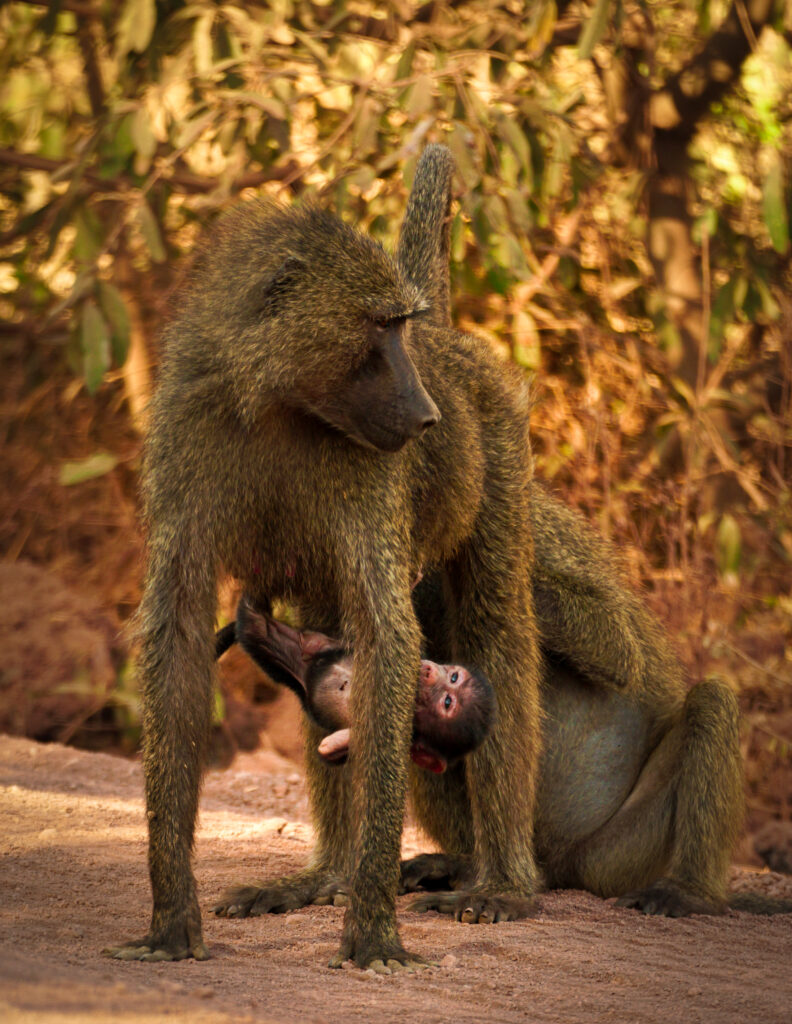
4. Ngorongoro Conservation Area & Ngorongoro Crater
The name “Ngorongoro” comes from the sound the Masaai cowbells make. The Ngorongoro Conservation Area is home to more than 20,000 semi-pastoralist Masaai who share the land with their roughly 300,000 livestock and wildlife. The area was established as a “multiple land use area” when it was separated from Serengeti National Park in 1959. Since 1979 it is listed as a UNESCO World Heritage Site.
Furthermore “engoro” means big depression or caldera and refers to the Ngorongoro Crater which forms a part of this unique and fascinating ecosystem. Often referred to as the “Garden of Eden” or “Garden of God”, the Ngorongoro Crater is home to all “Big 5” (Elephant, Rhino, Lion, Leopard & Buffalo). Additionally, it is home to many rare bird species, and other cats such as the Serval, and overall one of the most unique and beautiful places for a safari, in my opinion.
The Caldera is an impressive 600 meters deep and 100 miles in diameter. It is the world’s only non-flooded, non-broken Caldera. During our Serengeti Safari, our Guide told us that around 3 million years ago, the collapse of the Ngorongoro Mountain caused a large pressure wave, leading to the creation of Mount Kilimanjaro some hundreds of kilometers East.
The Route through the Crater
The Crater is relatively easy to navigate and you can get most of it covered in one day. I recommend taking a clockwise circuit, to see as much as possible and not crossing the same way repeatedly.
Our route was as follows:
- after entering through Seneto Gate we headed down the Descent road and took a sharp left at Seneto Springs.
- We then drove towards Engitati and near Endonyo Olkaria took a turn along the Mandusi Swamp, heading towards the Hippo Pool.
- We passed Lake Magadi and made our way towards Ngoitokitok Spring, which has a very nice Picnic Site for lunch. There are two picnic spots at Ngoitokitok: a public site and a special picnic site a little further on. This needs to be booked in advance, as far as I know. It seemed nicer and far less crowded. It might be worth looking into this if you know what day you will be in Ngorongoro Crater.
- After lunch, we headed back north and past the ruins of a former German Farm, back past Engitati, the Goose Ponds, and further south of the lake past Tatoga Ritual Site.
- Finally, we passed through Lerai Forest up the Lerai Ascent Road out of Ngorongoro Crater.
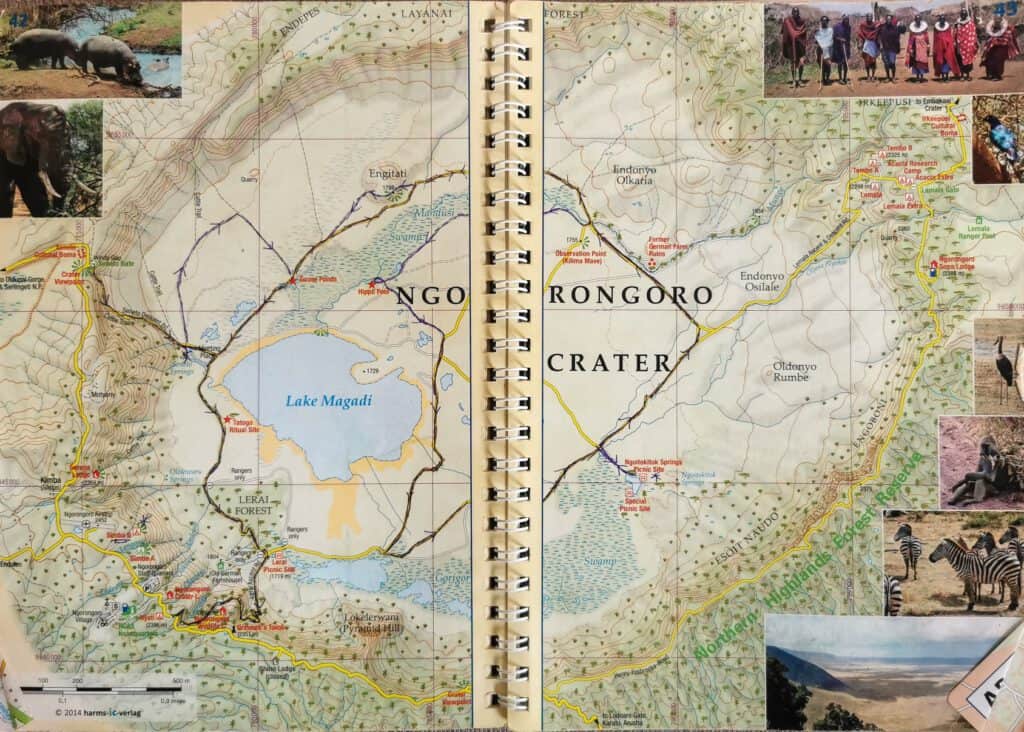
When is the best time to go on a self drive safari in the Ngorongoro Crater?
Ngorongoro is a very popular tourist destination. It is in “high season” most of the year and therefore gets many visitors. Most come from July to March, with April and May being the rainy season. Consider some of the following aspects when planning on your timing when to visit:
- High Season: July to March. The best time for viewing wildlife is June to October (best weather and almost no rainfall)
- Low season: April & May. Expect the worst weather, i.e. the peak of the wet season, around March & April.
Insider Tips: Ngorongoro Crater
- Get up very early. Plan to be at the entrance gate no later than 6 AM or latest 6:15 AM. This is easiest if you stay inside the NCA for the night.
- Self driving in Ngorongoro Crater is no problem with 4×4. The descent and ascent roads to & from the Gates are quite steep but very feasible, as it is a tarmac road.
- When planning your game drives, keep in mind animal migration patterns during the day. Animals are to be found near the escarpment in the morning and migrate towards the plains & lake during the day
- One of the nicest lunch spots in the Crater is at Ngoitokitok.
- In the afternoon head back in a large loop around the Crater
- When packing, bring some extra layers for the evening & night, as it gets quite cold in the NCA, due to the elevation & climate.

5. Serengeti National Park
The Serengeti National Park was established as a conservation area in 1951. Its name, quite fittingly, comes from the word “siringit”, which means endless plains. And this is absolutely true! Be prepared to be mesmerized by vast stretches of savannah, speckled with occasional “Kopjes” (little hills) here and there. The Serengeti covers an area of 30,000 square kilometers (11,583 square miles) of which around 14.763 km² are National Park!
It consists of many different landscapes – vast plains, hills, some mountains, (dormant) volcanos, escarpment (the rift valley) – and is home to over 2 million hoofed animals (ungulates), 4000 lions, 1000 leopards, 550 cheetahs, and 500 bird species.
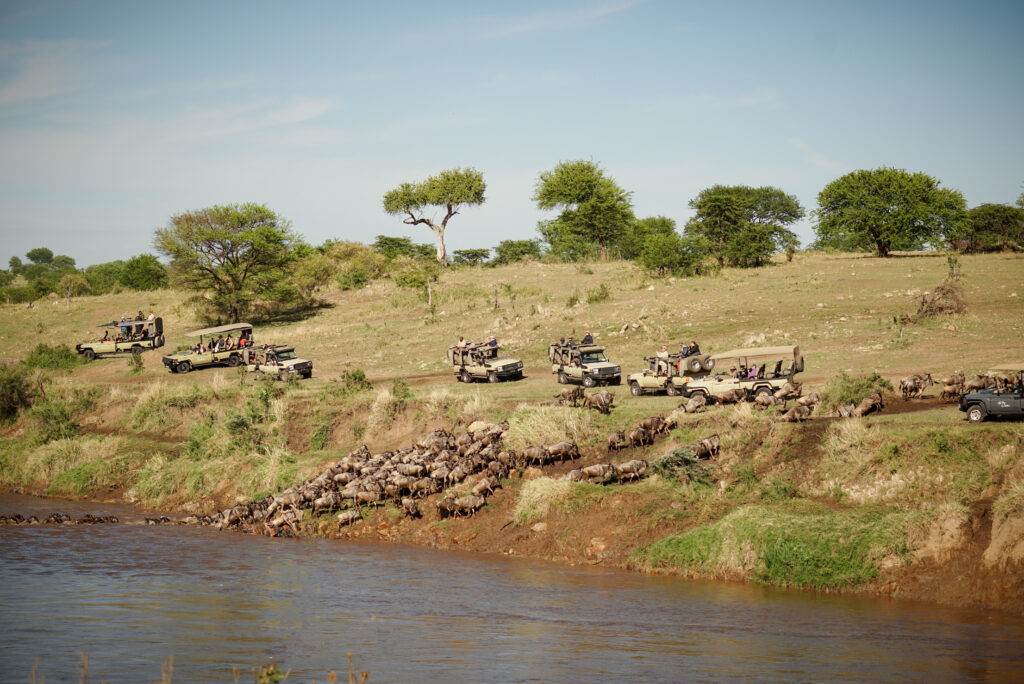
The Great Migration: timing your self drive safari to Tanzania
The Great Migration is the annual cycle in which over a million wildebeest migrate across the Serengeti and Masaai Mara in a circular motion following rains in search of food and water. They give birth to hundreds of thousands of calves and cross the Mara River in the north. This circle of life has been entrenched for thousands of years and helps the Serengeti ecosystem survive.
The year can be divided by month, best location & type of experience you will have:
- Calving Season (December to March): best experienced in the northern NCA and southern Serengeti. Around half a million calves are born (peaking in February), which draws thousands of predators and makes for great sightings.
- The trek north (April): the animals flock into the central Serengeti, while slowly moving north following fresh grazing areas.
- Mating season (May to June): best experienced in the Western Serengeti, animals mate but still keep moving. Some herds split off and head west towards the Grumeti river, where you can experience some first river crossings.
- Mara river crossings (July to October): arguably the most fascinating part of the migration. You can best experience this in the Northern Serengeti and Masaai Mara. Here you will witness wildebeests jumping into the Mara river from great heights and swim across the river, all while hungry crocodiles are waiting to prey.
- The trek south (November): know the Eastern and central Serengeti, animals can be seen migrating back south, crossing back from Masaai Mara into the Serengeti to follow the rains. By December you will see herds in Ndutu to begin calving and begin the process over again.
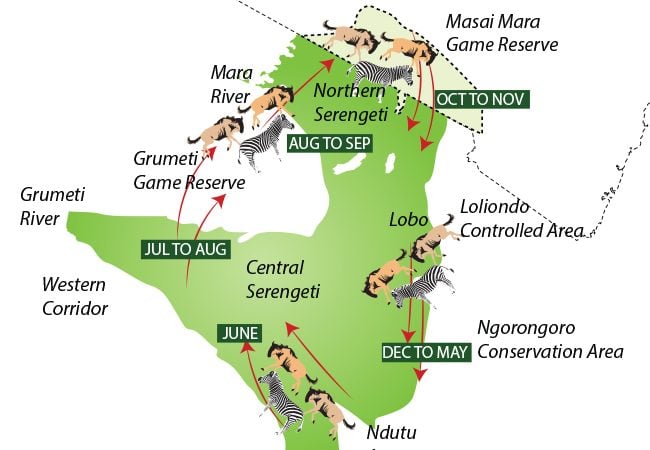
Different Areas inside the Serengeti
The Serengeti can be divided into different sections, depending on the timing of the Great Migration and the landscapes, flora & fauna you want to see.
South:
The southern Serengeti is accessible from Ngorongoro Conservation Area and can be entered via Naabi Hill Gate. The area sees wildlife peak in December to April (due to the cycles of the Great Migration). The grasses here are rich in phosphorus & magnesium due to the volcanic ash layer just below the soil.
- Naabi
- Kusini
- Maswa Game Reserve
- Ndutu Lake / Ndutu Region (high season in December to April, low season in April to November – still great viewing opportunities but much less people, as the Great Migration has moved north.)
Center:
Very accessible via NCA and reachable within a long day’s drive from Arusha. Seronera is characterized by accessible safari viewing, vast plains and is easy to navigate self-driving. It has good infrastructure: an airstrip, visitor information center (incl. small museum), coffee shop, picnic areas and many campsites & lodges. Furthermore, it is a starting point for many balloon safaris.
While enabling abundant wildlife viewings (especially big cat sightings such as lions, leopards & cheetahs) and providing good infrastructure it comes with a downside. It gets very crowded and is one of the most “touristy” parts of the Serengeti. You will often see over 20 vehicles parked near a sighting! When we saw a leopard, we counted 22 cars around us! This comes with a bit of a bitter taste, as you feel sorry for the animals while also battling with other safari cars for the “best spot”. Many drivers are quite aggressive and seem to care little about the animals’ wellbeing. Rather they focus on getting the “best photo”. While this is understandable to some degree, it also spoils the “magic moment” with the animal and authentic safari experience of feeling closer to nature.
- Seronera
- Namiri Plains (great for calving/predator sightings around March)
- Moru Kopjes (great lion & cheetah sightings)

West:
The so-called “western corridor” follows the Grumeti River from Seronera to Lake Victoria along a stretch of around 100 km. It sees high season in May-July, along the Great Migration route. The West is flatter than the north and is full of woodlands. The Grumeti Game Reserve is remote and sees far fewer visitors than other parts of the Serengeti.
- Grumeti River: great place to witness river crossings of wildebeest – often less crowded than the Mara & Sand Rivers to the North. The rare Colobus monkey species can be seen here.
- Grumeti Game Reserve: created as a reserve in 1994, this private reserve is managed by the Grumeti Community & Grumeti Fund since 2002. Besides the very exclusive safari experiences away from the crowds, this is also one of the few areas of the Serengeti where you can enjoy walking safaris and night drives. As it is not part of Serengeti National Park, it is therefore not bound by park regulations. This provides the chance to see nocturnal animals such as honey badgers, bat-eared foxes & aardvarks.
North:
The northern Serengeti has beautiful views over the Escarpment near the shared border with Kenya and fantastic sighting opportunities of the Mara river crossings of the Great Migration. This area is remote and takes around half a day’s travel to reach from Seronera area. The terrain is hillier (and roads bumpier) and generally a little more difficult to navigate when self-driving.
Due to the remoteness of the area, it gets fewer tourists, which means a much more private safari experience. However, during peak Migration times, we experienced some negative situations where some tour operators practiced very unethical safari behaviors. They broke Serengeti rules by crowding the wildebeests as they were emerging from the Mara River, blocked their paths, and did not keep distance from the river. They got too close to the animals, which panicked and jumped back into the river or cut off migration movements that had built up momentum. It was disappointing to experience. Our guide said that this behavior has become common practice, as officials, rangers & politicians turn a blind eye to this so as not to inhibit tourism to the area.
- Serengeti Mara: to get here, you need to cross a concrete causeway through the Mara River near Kogatende Rangers Post. This can truly be a little intimidating to do! It is less visited, and therefore a great opportunity for river crossing sightings during the Great Migration. Furthermore, it is home to a small population of rhinos. Before the 70s, this area was often visited by Masaai Mara tourists, however after the border between Kenya & Tanzania was closed, it became much quieter.
- Kogatende
- Nyamalumbwa Plains
- Lamai Wedge (on the other side of the Mara river)

East
Characterized by rolling, green hills and denser vegetation than the Serengeti plains around Seronera this place may be a little tougher for sightings but sees far fewer visitors.
- Lobo
- Loliondo Game Controlled Area (LGCA): not part of the Serengeti National Park, this part is accessed via Klein’s Gate in the North.
- Klein’s Camp: a concession within the LGCA, which – similar to Grumeti River Reserve – is one of the few areas of Serengeti offering nature walks and night game drives.
Is it possible to combine the Serengeti with the Masaai Mara?
By road
While planning our stay in the Serengeti we had thought about transiting through the northern Serengeti into Masaai Mara in Kenya to get the best of both worlds and see the Great Migration in both countries.
Unfortunately, while researching, we learned that it’s not possible, as the border between Tanzania and Kenya at Bologonja (Sand River Gate) is closed.
There are two possible ways to cross the border by car: at Isebania (west of the Serengeti) or Namanga (east of the Serengeti). These options are possible, but not very convenient, as both take a very long time, have tough road conditions, and are major detours.
At the Isebania border, roads are uneven on both sides and the time to get from Mara to Isebania and onwards to Serengeti will easily take you a day. Furthermore, waiting times at the border can take between an hour to several hours, depending on traffic. An overnight stay may be necessary. At Namanga, the road conditions are a little better, however, it is quite far off from both the Serengeti and the Masaai Mara.
These factors are further compounded by complications around getting a driving permit for the other country. Tanzania does not let cars with Kenyan license plates into the country, and vice versa. This can be avoided by having a Ugandan license plate, which you may be able to arrange via Roadtrip Africa, which has rental cars in all these countries and can advise you on the best option. Furthermore, these permits are also quite expensive.
By Air
If you plan to add just a couple of safari days in the Masaai Mara, your best bet would be to travel by Air. You can take Safari Link flights (e.g. via Serengeti – Tarime (Isebania) – Migori – Masaai Mara), which are quite expensive. These can be arranged by providers such as Kabira Safaris or Africa Sky.
For us, in the end, it was not worth it to combine Kenya and Tanzania within this trip: meaning we have an excuse for a separate trip to Kenya at a later time! 😉
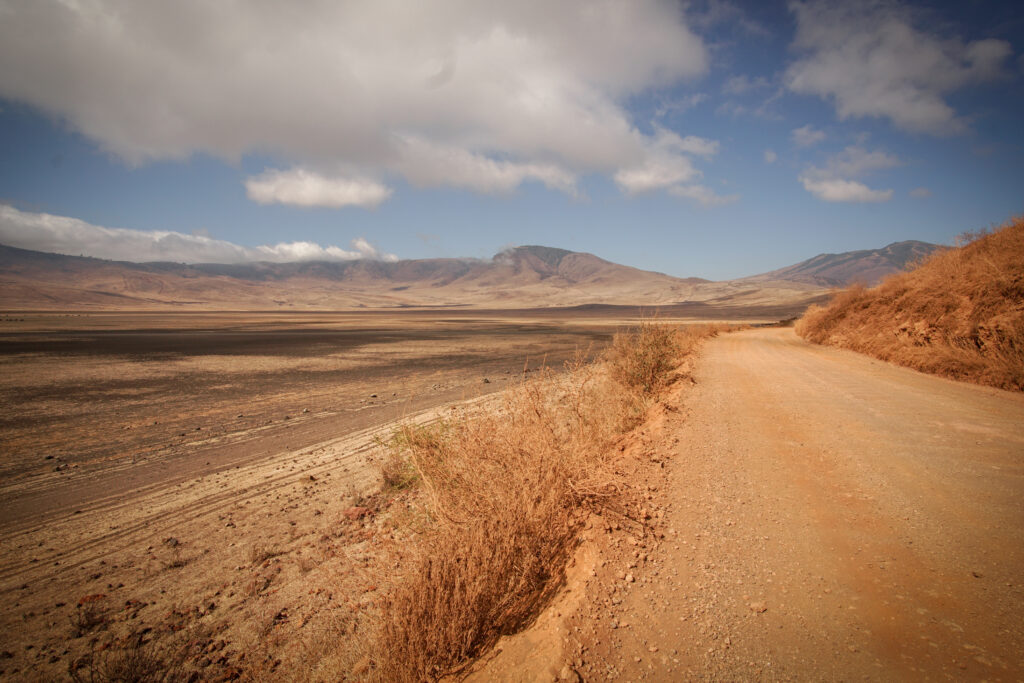
Insider Tips: Serengeti
Planning your self drive safari in Serengeti National Park
- Night drives and walking safaris/nature walks are not possible in the Serengeti National Park. These are allowed only in private game reserves (e.g. Grumeti River Reserve or Klein’s Camp). So if this is something you want to do, plan a part of your safari in one of these places.
- If you have time (at least 4 nights), visit different parts of the Serengeti National Park: South, Central and/or North, as they all offer different landscapes and viewing opportunities.
- West Serengeti is known for many Tsetse flies: you know the drill – don’t wear black or blue.
Permits, Gates & Navigation
- When you reach Naabi Hill Gate and the Permit office, make sure you queue in the right line to get your permit! There is a check-in and a check-out desk, which are not very clearly marked.
- You can navigate Serengeti NP via GPS on maps.me. However, be careful: not all river crossings are correctly labeled. To be 100% sure if it is safe to cross, do so only if you can see that cars have already passed through (we saw one safari jeep – also self-drivers) get stuck and they had to be pulled out with a tow rope.
- When making a booking in North Serengeti (incl. Full Game Package), make sure your Lodge/Accommodation sends you a Reservation number in advance. You will not be able to check in without this. Unfortunately, this cost us some extra time at the Tabora “B” Gate.
Self Drive Safari Tips
- While on safari, follow crowds of cars – they are a giveaway sign of an interesting sighting (often big cats).
- I recommend you split up your game drives throughout the day to make most of your time (and to not get too exhausted). Plan one morning drive – start at around 6:30 am – 7:00 am (latest!) to around noon – 1 PM. Pause for lunch. If possible, return to your camp/lodge and go on a second drive in the afternoon: from around 3:30 pm to around 6:30 pm, when it gets dark.
- No driving after dark: this means keep off the main road after about 6:30 / 7 pm. Otherwise, you can get fined by Rangers (750 USD!)
- At a sighting always park directly at the sighting, leaving no road space between yourself and the animal. At “cool” sightings we’ve witnessed it become a kind of “war” scenario: a battle for the best sighting spot. At a leopard sighting, you can expect up to 20+ jeeps! We’ve had scenarios when we parked in a respectful distance to the animal only to have another safari jeep rudely park right in front of us and block the view. We were battling a little with our conscience of not getting too close to the animal vs. getting blocked by other drivers and not seeing anything.
- When you get a chance, ask guides from other cards en-route about their sightings. You may get some valuable hints where to go next. Also, when asked, do the same. Sharing is caring!
Good viewing locations
- Kopjes (e.g. Simba Kopjes or Gol Kopjes) are good for spotting lions & cheetah as they serve as both shelter & vantage points of the surrounding plains.
- It is possible to see Rhinos in the Serengeti. However, you need to get a special Rhino Permit & book a tour to see them. They are located in a special area, to ensure extra protection.
- If you are in the Northern Serengeti to witness the Great Migration, crossing #4 is the most popular.
For more tips & helpful information check out my “Ultimate Guide to Self-Driving in the Serengeti” here (coming soon).

6. Lake Natron: the last stop on your self drive safari in Tanzania
If you like to travel “off the beaten track”, enjoy a little bit of adventure and don’t want to drive back the same way you came, I’d recommend you include Lake Natron in your Self drive safari itinerary in Tanzania.
Lake Natron lies east of the Serengeti, north of the Ngorongoro Crater near the Kenyan border. Lake Natron is a large soda lake with very high acidity levels, making it a very harsh environment for many animals to survive. Birds who mistakenly dive into the water burn their skin and die on the shores of the lake. Despite this, it is one of the largest breeding grounds in the world for greater and lesser flamingos. They feed on red pigments & algae and enjoy this largely predator-free zone. If you visit in December or January, you will witness their eggs hatching and find the shores filled with birds.
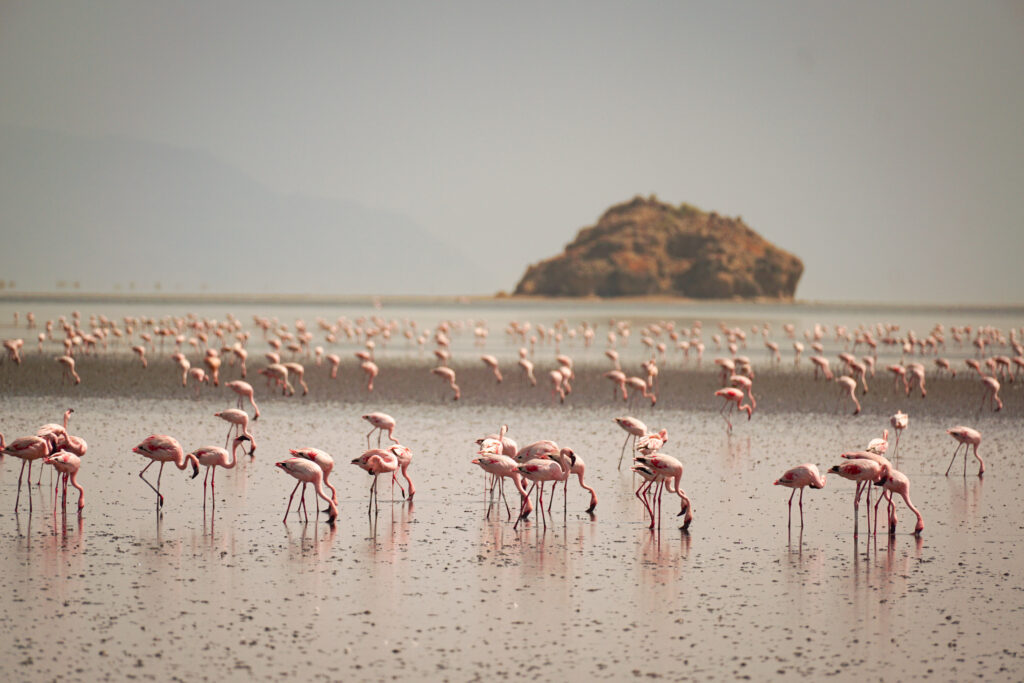
Consider the temperatures when you visit: from June to August you have the most pleasant temperatures, while the rest of the year it gets very hot.
As Lake Natron lies in a remote part of northern Tanzania, I advise you spend at least 2-3 nights there to make it worth it. The route from Kleins Gate to Wasso has initial stretches of gravel road (that can get rather bumpy), followed by a longer stretch of very enjoyable tarmac road, and again a gravel road from Wasso to Sonja.
The trickiest part is surely the last 20 km leading from Sonja to Engare Sero village on Lake Natron. The road is extremely bumpy and took us 1-2 hours.
Things to do around Lake Natron
Three main activities can be done when visiting Lake Natron.
Climb Mount Ol-Doiyno Lengai
At an elevation of 2960 m, this active volcano majestically overlooks the landscape. Climbing this volcano is one of the toughest hikes in East Africa, with a total distance of around 13 km, an elevation gain of ca. 1,600 meters, and a duration of 12 hours. You start at midnight to make it to the rim at sunrise and get back down by noon, before it gets too hot. Views from the top are spectacular, as is the feeling of pride that comes with completing the tour. Although we really wanted to do this hike, I was not quite feeling up for it. This remains on our bucketlist for our next visit to Tanzania!
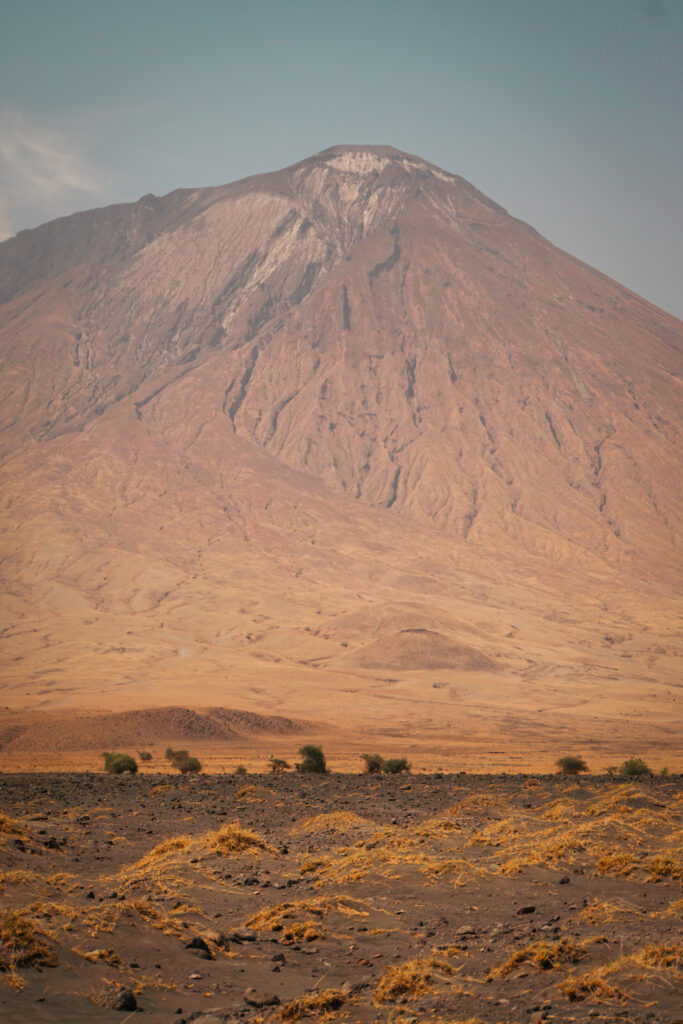
Shores of Lake Natron & Flamingo Walk
This is a fun nature walk, that takes you to the shores of Lake Natron to see the thousands of flamingos. The drive is a little adventurous, as you navigate through sand for some of the way.
Engasero Waterfall
Our favorite activity while at Lake Natron, this was a beautiful nature walk through a gorge, leading to a waterfall and natural pool. We swam in the refreshing, cool & clear water and enjoyed some time in spectacular nature. The walk is not too tough and can be easily done at a decent fitness level. Make sure you wear waterproof shoes (or shoes you don’t mind getting wet), as some of the route leads through the water. Don’t bring any valuables or electronics as there is a high risk of them getting wet. Or, if you have it, I recommend bringing a small drybag for items such as phone, car keys or camera.
Note: all activities need to be done in the company of a Masaai Guide (and cost the activity fee of $11.80 per person, payable to the Community Center in Engare Sero). Our guide’s name was Lembu. He speaks English and we recommend booking him. His number ist: +255 685235561.

7. Zanzibar: time to relax
Postcard-like white sand beaches, unforgettable sunsets, and a vibrant, unique culture & history: Zanzibar has lots to offer! Especially after an adventurous self drive safari on the Tanzanian mainland, it is the perfect way to unwind, reflect on your experiences and take some relaxing days off before heading back home.
Zanzibar, an archipelago off the coast of Tanzania, boasts a rich and fascinating history. In the 19th century, Zanzibar was a significant spice trade hub, particularly known for cloves, nutmeg & cinnamon. Its strategic location between Africa, the Middle East and Asia helped establish it as a crucial economic center. However, this had its price: it also played a significant role in the East African slave trade, selling enslaved people from East Africa to the Arab world. The blend of African, Arab and Indian cultures is still evident in today’s traditions, cuisine, and architecture.
Zanzibar was a Sultanate of Oman from the 17th to the 19th century and later came under British rule. It gained its independence in 1963. Together with Pemba Island and other smaller islands, it joined with mainland Tanzania (then Tanganyika) in 1964 to form the United Republic of Tanzania.
Stone town, Zanzibar’s capital, is a UNESCO World Heritage Site, renowned for its interesting architecture. Winding alleys, spice markets, intricately carved wooden doors and historic buildings pay homage to its vibrant history. It is a city of contrasts with a very unique vibe. Zanzibar is also the birthplace of Freddie Murcury, Queen’s legendary frontman. You can visit his museum in Stone Town.

Planning your stay in Zanzibar
Planning your stay in Zanzibar can be a little tricky. Here are some tips to help you make the most of your trip.
Location, location, location
Knowing the upsides & downsides of staying in the North, East, West & South is very important for planning your trip. Zanzibar is highly affected by tides, due to its location, oceanic tides, and shape of its coastline. In some parts of the island, the sea can withdraw up to 1,5 km! This is also accompanied by seaweed on the shore. Therefore, if you primarily aim for a “classic” beach holiday, I advise you stay in the northern parts of the island e.g. Nungwi and Kendwa or on the South-East – Paje & Jambiani. These areas see the weakest tidal differences.
If you have time, spend at least one day in Stone Town. This city is fascinating. It is vibrant, bustling, chaotic, and a wonderful melting pot of African, Arab and Indian cultures.
Local Customs and religion
When visiting Zanzibar, keep in mind that the island is predominantly Muslim. Especially when visiting public spaces (outside your hotel/resort), walking around Stone Town, make sure you dress appropriately & modestly (i.e. don’t show too much skin). In your hotel selection, if you have a light sleep, it may be worth checking on the map if the hotel is next to a mosque (as you may be woken by the calls of the muezzin at dawn). In this case, bring earplugs! 😉
Activities
There are many fun activities in Zanzibar. You can book tours directly with one of many operators online or just ask in your hotel and they can arrange something for you.
- Stone Town: Visit the night food market
- Swimming with turtles at Mnemba Atoll Marine Reserve
- Snorkeling with whale sharks at Mafia Island
- Sunset Dhow Cruise (on a traditional Zanzibari boat = “dhow”)
- Visit Joziani Forest and see the rare Red Colobus Monkeys
- Go on a Spice Tour to see where & how the spices are grown
- Full moon party in Nungwi

Zanzibar Accommodation Tips:
- In Stone Town, I highly recommend staying in the Zanzibar Coffee House. Our room was very nice, located in a beautiful, traditional house in the city center with a beautiful view over Stone Town from its rooftop. Even if you don’t stay there, I recommend you stop by for a delicious coffee or snack and a fantastic view from the top story.
- If you want to splurge on a fantastic hotel in Zanzibar (as we did for our Honeymoon), a stay at the Kilindi Zanzibar is worth every cent.

In a nutshell: Is a self drive safari in Tanzania worth it?
If you want to self-drive primarily to save money, I recommend you reconsider. Self-driving will not save you significant amounts of money. Rather, it could even end up more expensive than booking a “generic safari” with a tour operator.
Consider that guides are experienced and know the parks very well, i.e. where to best spot animals. So if you have limited safari experience, you could get more value out of the trip if you go with an experienced guide rather than relying on your own sighting skills.
Also, if you have never driven in an African country before or have limited off-road driving experience, I would not recommend Tanzania as your “first try”. You are better off starting with countries such as South Africa or Namibia, which are a little easier to navigate.
Lastly, if you are uneasy at the prospect of things “going wrong” then a self drive safari in Tanzania may fill you with more anxiety than positive emotions. Flat tires, problems with your vehicle or uncomfortable animal encounters can happen at any time. If you’d rather not deal with this, it may be better for you to spend your safari in the company of a professional guide.
If these points don’t apply to you or don’t scare you, your self drive adventure will offer boundless freedom, flexibility and a dash of adventure. For us, it was one of the most memorable trips to date and will surely stay with us for a lifetime.
Both experiences can be very rewarding and have their pros and cons depending what you are looking for. Below you will find my summary of pros & cons.
Pro: Self drive safari in Tanzania
- Flexibility: You are a master of your itinerary & can customize the trip exactly the way you want (or make changes on the go!).
- Own tempo: you can go at your speed, take as much time as you want at any given spot, pause, and don’t need to worry about the group or anybody else setting the tempo for you. In a country like Tanzania where everything is “pole, pole” (slowly, slowly), this can be an important asset. Also, when on safari, you can hang out and stay at a sighting for as long as you want, without feeling rushed.
- Closer to nature & more intense experience: in your own car, you are much more tied to your surroundings, more alert, and experience the entire trip more intensely, than just riding in the back seat. In other words, “the journey is the reward”.
- Adrenaline kick: for those seeking some more adventure during their vacation, your own car will take you on plenty of adventures. In the good and the bad.
- Less risk of being in a group you don’t like: when traveling in a group, different people have very different ideas of how to spend the day, what they find interesting, what not, when to start- and end the day, etc. This can lead to disappointment & frustration.
- A sense of pride with every sighting: when in your vehicle, you are on your own during the safari. This means every sighting you have is due to your spotting, which can be rewarding. (this can also be a con, see below).
Con: Self drive safari / Pros: Guided Safari Tour
- Drives can be long and exhausting. Without a travel buddy, you may be better off booking a Safari Tour.
- Much less headache with planning & organizing: you book the tour and don’t have to worry about a thing. You get pick-up service, have all accommodation booked in advance and don’t need to focus on planning, getting permits in advance, etc.
- Guides have a trained eye for animal sightings: Although it is very rewarding to spot your own animals, guides are trained to see animals and know how to recognize patterns. This means, that you have a higher chance to see animals, especially if you haven’t done this before and often don’t know what exactly to look for.
- Guides have walkie-talkies: in the National Parks, guides often have a walkie-talkie or communicate on radio frequencies. They share spots of good sightings and drive through the park relying on where there were previous sightings in the park by other guides. This will also increase your chance of seeing an animal by “freeriding” on all the guides’ sightings in the parks.
- You can focus on the animals, not the road: while you are on a tour, you don’t need to worry about concentrating on the road and driving and navigating. You can just sit back and enjoy the ride.
- Stories & Information: guides will often share interesting stories with you or general information about the animal, the park, the landscape, history, people & culture. This can give some great additional information and put your trip in a “bigger picture”.
So: is a self drive safari in Tanzania the right choice for me?
As you can see: there are many pros but also some cons of doing a self drive safari in Tanzania vs. going on a pre-organized tour. So it comes down to your individual travel preferences and what you are looking for.
If you do it smartly, you can also combine some pros from both sides to get the best outcome. For example, you can still “free ride” on guides in the National Parks, by following groups of cars, asking for sightings and using common sense. Furthermore, something we did was to book a full Game Package in the northern Serengeti and therefore combine our self drive safari with some selected Guided Game drives to get the best of both worlds.
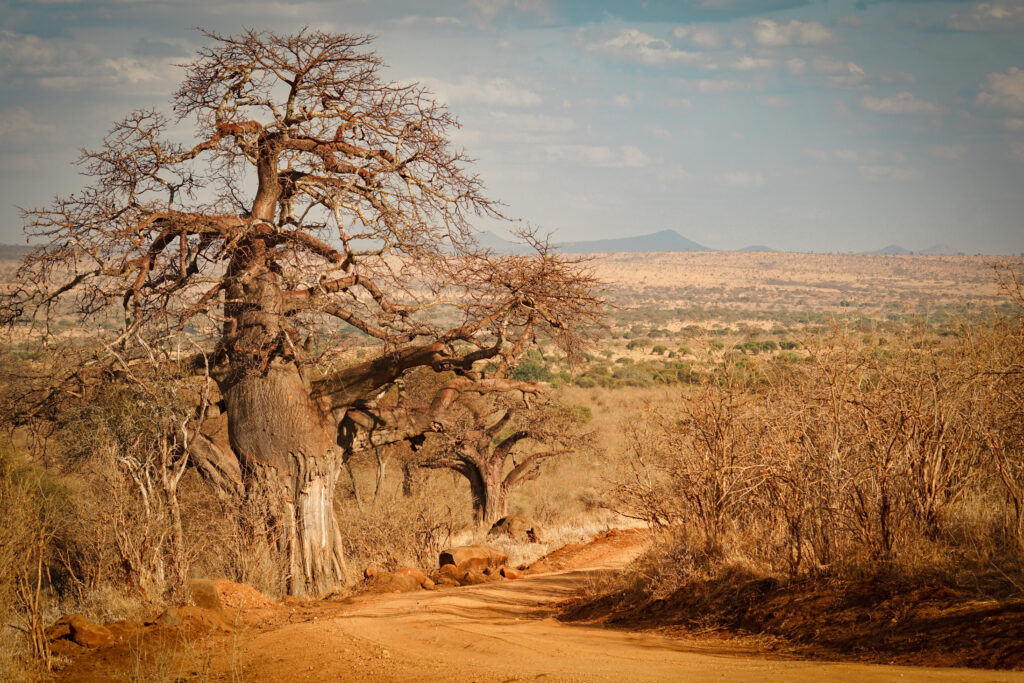
What’s next?
Looking for some more travel inspiration in Africa? Check out my Namibia travel guide here or this post on my 3-week Namibia road trip itinerary.
You May Also Like
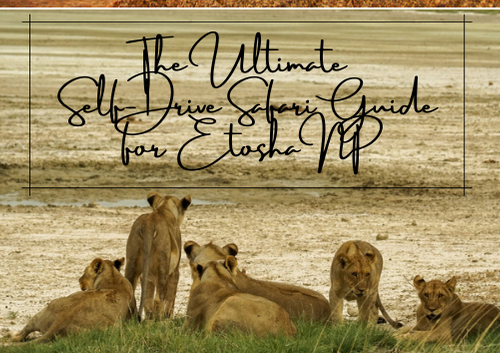
Self-Drive Safari in Etosha National Park: 20 Do’s & Don’ts
May 12, 2021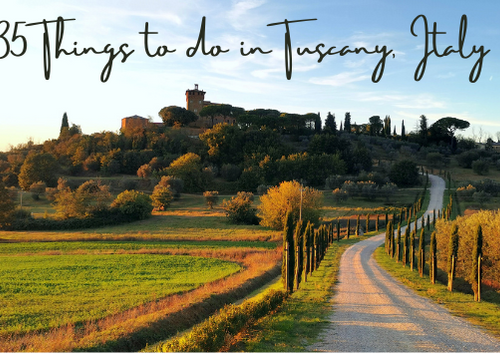
The 35 best things to do in Tuscany, Italy
September 29, 2021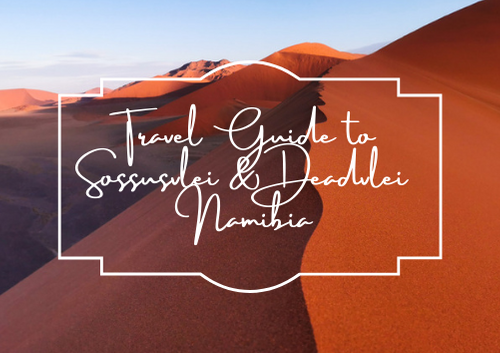

2 Comments
Mfuwe
Congratlatons on an excellent and comprehensive account and guide on Self Driving in Northern Tanzania. Lots of good information there for beginners and experienced safari goers alike.
Like many detailed accounts it does contain a few small errors of fact but they don’t spoil the overall effect of the article.
I give three that may help you get more accuracy.
1. Dar es Salaam is not the capital of Tanzania. Tat distinction falls on the town of Dodoma in central Tanzania.
2 Your piece on the river migrations I did not understand. It is impossible for waters from Amboseli, Tarangire and Serengeti to mix. There are large mountains separating the systems. Amboseli water goes to the Indian Ocean, Serengeti to Lake Victoria and ultimtely the Mediterannean whilst Tarangire river goes into Lake Manyara and evaporates which is why it forms a soda lake of the Rift Valley like Natron further north.
3. Ungulates are not all hoofed. Ugulate means a vegetable eater or browser. Some have hooves other just have toes. viz, Rhino and Hippo. Elephants are not Ungulates but oddly Dolphins and Whales are. A better example are Horses, and Zebras, odd toed ungulates and Cows and antelope with ‘split’ hooves or even toed Ungulates.
As I say these errors do not really detract from the overall enjoyment of your hard work.
lisa.begusch
Hey Mfuwe,
thank you for the props and your helpful feedback!
Duly noted. The piece on natural geography came from our Nature guide – maybe he got some things wrong as well 😉
Have a great day & enjoy Tanzania!